The Surprising Story of the American Girl Who Broke Through the Iron Curtain
Samantha Smith was only 10 when she wrote to Soviet General Secretary Yuri Andropov about the Cold War. In response, he invited her for a visit
/https://tf-cmsv2-smithsonianmag-media.s3.amazonaws.com/accounts/headshot/lorraine.png)
Lorraine Boissoneault
/https://tf-cmsv2-smithsonianmag-media.s3.amazonaws.com/filer/82/b3/82b3643a-689e-43aa-9f85-45bf46aea497/1024px-rian_archive_793152_us_girl_samantha_smith_in_artek-wr.jpg)
Even at age 10, Samantha Smith already knew important things about the world. She’d studied World War II and the dropping of atomic bombs on Japan. She listened to newscasters speak in dire terms about missiles and the Cold War, and she watched a science program about what would happen to Earth’s ecosystems if nuclear war broke out. One morning the Maine schoolgirl woke up wondering if this very day might be the last one for all of humanity.
After Samantha confessed her fears to her mother, Jane Smith brought out the November 22, 1982 issue of Time magazine that featured Soviet General Secretary Yuri Andropov on its cover. The new Russian leader had just taken power, and Jane suggested her daughter write him a letter. Samantha did so, asking bluntly , “Are you going to vote to have a war or not? … I would like to know why you want to conquer the world or at least our country.” The letter was posted in December 1982, and Samantha continued the normal course of her life.
Until the Soviet newspaper Pravda (the official paper of the Communist Party) published excerpts of the letter several months later, with comments from Andropov himself.
Upon learning that her writing had appeared in the paper, Samantha wrote a second letter, this time to Soviet ambassador to the United States Anatoly Dobrynin, wanting to know why Andropov hadn’t responded directly to her. On April 26, 1983, the Soviet leader did so—and invited Samantha and her family to visit the U.S.S.R. “You will find out about our country, meet with your contemporaries… and see for yourself: in the Soviet Union, everyone is for peace and friendship among peoples,” Andropov wrote in Russian, accompanied by an English translation.
So began the unlikely adventures of Samantha Smith, dubbed “America’s Youngest Ambassador” by the press, as she took up Andropov’s offer and visited in July of 1983. While her visit to the Soviet Union had little impact on the policy decisions of Andropov and President Ronald Reagan, nor did it turn the course of the Cold War, it offered proof to citizens of both nations that the other was, in fact, human.
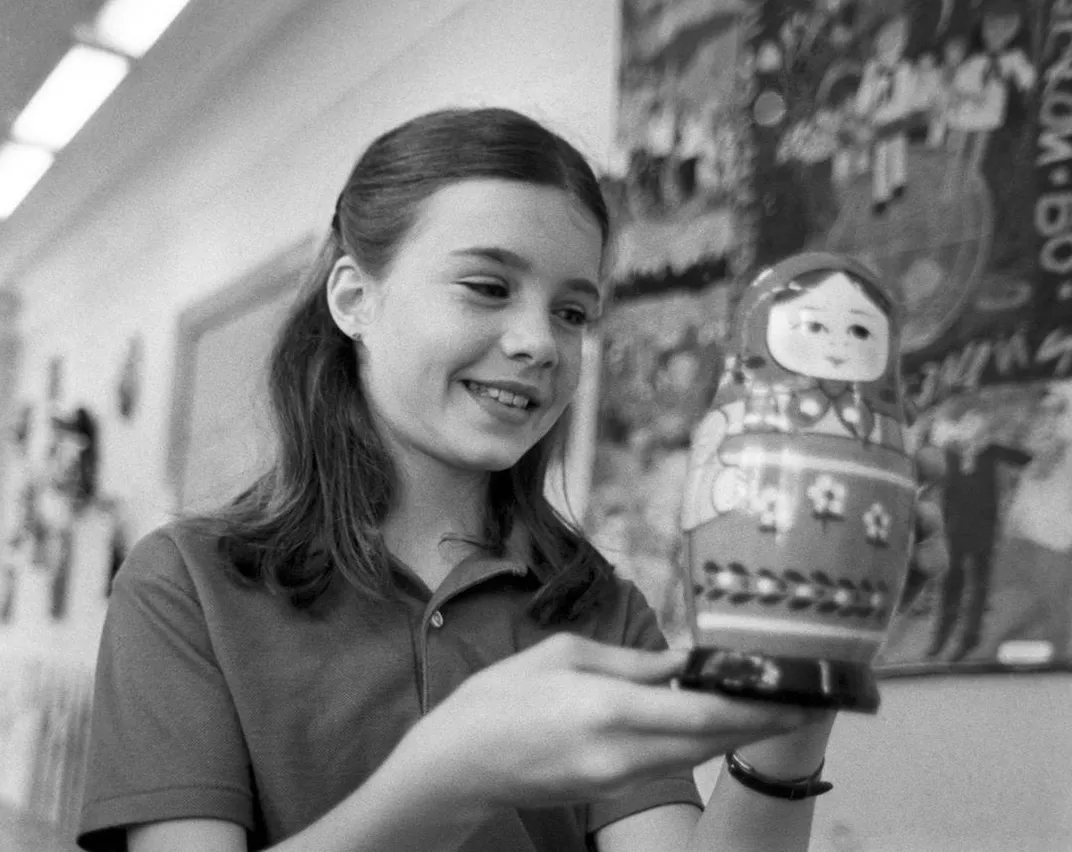
1983 was a perilous moment in the Cold War—just that March, Reagan delivered his “ Evil Empire ” speech, calling for increased military spending and a modernized nuclear stockpile to thwart the Soviet Union. Meanwhile, in the Soviet Union, Andropov compared Reagan to Adolf Hitler.
But it wasn’t only heated rhetoric causing heightened fears; the respective militaries also seemed to dance on the line between détente and war. While Americans worried about SS-20 missiles pointed at them, the Russians feared Pershing II missiles that could “fly 1,000 miles in six to eight minutes, and land with high accuracy and virtually no warning,” according to the Washington Post . As Soviet leader Mikhail Gorbachev would later say , “Never, perhaps, in the postwar decades was the situation in the world as explosive and hence, more difficult and unfavorable, as in the first half of the 1980s.”
With her parents and a press entourage to rival any celebrity, Samantha waded into the thicket of Cold War politics. Over the course of two weeks, she visited Lenin’s grave and the Bolshoi Ballet; made friends at the Artek summer camp in Crimea and met Valentina Tereshkova , the first woman to go to space. Soviet and Western press followed her every footstep, documenting all the encounters and the girl’s reaction. “Some people have the wrong impression about the Soviets,” Samantha told the reporters. “[They] want peace like I do.”

It was a message that resonated with people from both countries. Writer, teacher and historian Lena Nelson, who is currently at work on a book about Samantha, grew up in the Soviet Union and vividly remembers the young girl who visited her country. “For my generation of the Soviet children growing up in the early 1980s, the word ‘American’ meant only one thing—an enemy, similar to that of the Nazi Germany during WWII,” Nelson said by email. “Seeing Samantha and her parents on my TV that summer and realizing that they looked and acted ‘just like us’ was an eye-opening experience. It was hard to think of Americans as enemies.”
The media fascination with Samantha’s story only increased after the Smiths returned home. She appeared on “The Tonight Show with Johnny Carson ,” interviewed Democratic presidential candidates for the brand-new Disney Channel, and began writing her own book. In interviews, Samantha described the Russian kids being just the same as those she knew in the United States, and said, “They were just really nice people to me.” The incident was even parodied on an episode of the sitcom “ The Golden Girls ,” when Rose pens a letter to Gorbachev and is mistaken for a child.
But with the intense coverage came questions about whether Samantha had been used as a pawn by both governments to distract from the real problems. Reporters at United Press International pointed out that the Smiths had brought with them on their trip hundreds of letters from Russian emigres living in the United States hoping to acquire exit visas for their relatives, but none were issued. And a letter to Andropov from a Soviet girl named Irina Tarnopolsky made the rounds in the American press, describing how the girl’s Jewish family hoped to emigrate to Israel, but her father had been arrested for anti-Soviet agitation . Unlike Samantha, Irina never received a response and her father was sent to a Siberian work camp. (It was later discovered Irina signed the letter, but didn’t write it ; eventually the Tarnopolsky family was able to leave Russia.)
Nelson argues that in speaking for herself as a regular, American girl, Samantha had an impact that superseded general mistrust of the governments’ intentions. “While it is possible that the Soviets’ goal was to use her to project an image of a peace-loving nation, Samantha and her parents’ trip also placed the Americans in a favorable light, thus making it harder for the Soviets to continue with their depictions of Americans as evil warmongers,” Nelson said.
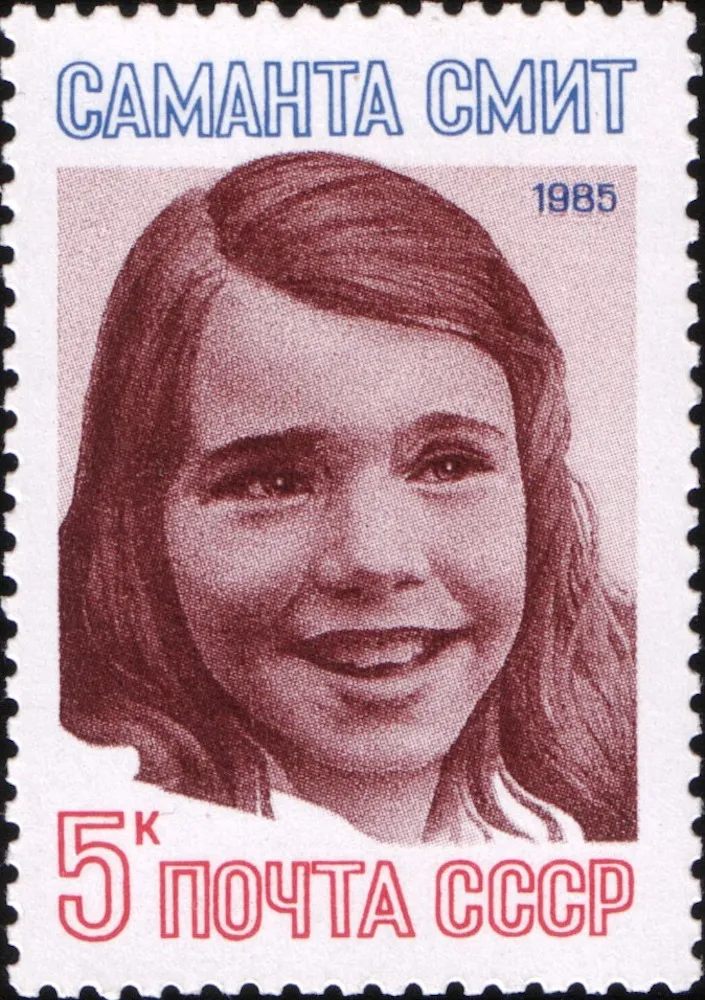
In the months after Samantha’s tour as “Goodwill Ambassador,” Soviet and American relations continued to deteriorate. The world nearly fell into nuclear war during a November training exercise by NATO and American forces called “ Able Archer .”
“The leaders of the superpowers hadn’t met in years and dialogue had broken down on a number of tracks,” says Marc Ambinder, a professor of journalism at the University of Southern California and author of the forthcoming book The Brink: President Reagan and the Nuclear War Scare of 1983 . “I don’t think [Samantha’s trip] had much of an effect, but it did reflect the cross-current of Americans generally being skeptical of a nuclear buildup.”
As the Cold War continued to simmer, Samantha seemed prepared to stay in the public eye as a token of what could be achieved by curiosity and openness. But in August 1985, Samantha and her father were killed in a plane crash on their way home to Maine. The following year, Samantha’s mother, Jane, returned to the Soviet Union with 20 of Samantha’s classmates and visited some of the numerous memorials for her daughter. For years, Jane also spearheaded a foundation that promoted cultural exchanges between students in the U.S.S.R. and the United States.
Although Samantha’s journey may not have altered the war, Ambinder does believe that cultural exchanges have an impact on how nations see each other. “They’re often ordinary people or academics or doctors and professionals who are providing much more granular descriptions of what everyday life is like,” Ambinder says.
And for a few years, that window into ordinary American life was offered by Samantha and her family.
Get the latest History stories in your inbox?
Click to visit our Privacy Statement .
/https://tf-cmsv2-smithsonianmag-media.s3.amazonaws.com/accounts/headshot/lorraine.png)
Lorraine Boissoneault | | READ MORE
Lorraine Boissoneault is a contributing writer to SmithsonianMag.com covering history and archaeology. She has previously written for The Atlantic, Salon, Nautilus and others. She is also the author of The Last Voyageurs: Retracing La Salle's Journey Across America. Website: http://www.lboissoneault.com/
Watch CBS News

Samantha Smith, the fifth-grader from Maine who became "America's Littlest Diplomat"
By Mo Rocca
January 29, 2023 / 9:43 AM EST / CBS News
In 1982, at one of the frostiest moments in the Cold War, a fifth-grade girl from Manchester, Maine named Samantha Smith wrote a letter to Soviet Union Leader Yuri Andropov. "I have been worrying about Russia and the United States getting into a nuclear war," she wrote. "Are you going to vote to have a war or not? If you aren't, please tell me how you are going to help not have a war. P.S. Please write back."
As she explained to CBS News at the time, Samantha said, "It's a little bit hard to understand the news, because they put it in grown-up words."

But when Andropov did write back, it made national news.
She went on "Nightline," with Ted Koppel:
Koppel: "You've got quite a pen pal there, Samantha. What did he write to you?" Smith: "Well, I asked him why he wanted to conquer the world. And he wrote back to me and said he wanted nothing of the kind."
In his letter Andropov invited Samantha and her parents to visit the Soviet Union, where she was treated like a superstar.
Laurie Labar, curator of the Maine State Museum in Augusta, showed Rocca Polaroid pictures Samantha had taken of the crowds. She said, "There's a couple pictures here where you just see there's photographers everywhere" - all busy taking pictures of her .

During their two-week trip, Samantha became one of the Cold War's most improbable peace ambassadors. Why the Kremlin invited Samantha to the USSR was a matter of speculation.
"That was one of the concerns that people had in the United States about her going, that she was gonna be a tool of the Soviets, a propaganda dupe," said Labar. "I don't think anybody was prepared for Samantha, frankly, because she was guileless. I think that just enchanted everybody."

At Camp Artek in Crimea, Samantha was welcomed by thousands of Soviet kids, few of whom had ever even met an American. In a camp tradition, she threw a bottle with a message of peace into the Black Sea.
An editorial cartoon by Don Wright, of The Miami Herald, depicts Samantha Smith leaping from one nation's nuclear warhead to another, "which I thought was a fabulous encapsulation of her whole trip," said Labar.

Back home in Maine, Samantha was greeted with a parade, and she charmed Johnny Carson on "The Tonight Show."
Johnny Carson: "Do you know what Bolshoi means?" Smith: "Great." Carson: "Yes, great, or big. That's all it means." Smith: "I thought you didn't know Russian."
Today at Manchester Elementary, the very school Samantha went to 40 years ago, students learn about her peace mission.
One student, Meika, said, "She communicated with love and kindness, and she made the world a better place."
Another, Hunter, said, "Makes me feel like even kids at my age can make a big world change."
"I think she still wanted to be a normal 11-year-old girl," said Jessica Dwyer, who was Samantha's classmate and a close friend. She said Samantha never bragged about what a big deal she'd become … except for that time she made a guest appearance on the sitcom "Charles in Charge." "'Cause of Scott Baio, of course!" she laughed. "I mean, my only request was that she bring back his autograph. And she did!"
Sadly, Samantha Smith's life ended only two years after her trip to the Soviet Union. In 1985, heading home from filming a TV series, the small plane she and her father were in crashed, killing all eight on board . She was 13 years old.
- 1000 jam church in girl's memory (New York Times)
Rocca asked Dwyer, "How did your 13-year-old brain even process that she had died?"
"It took me a long time to accept it," she replied. "And I'll share this, I haven't shared it with very many people: I always thought that she and her dad escaped the plane and were in a tree, living this great life. And I think that was just my way of keeping her memory alive."
Today, there's a statue of Samantha in Augusta – a monument to the girl nicknamed "America's Littlest Diplomat."
Listen to the "Mobituaries" episode "Samantha Smith: Death of a Peacemaker"
For more info:
- "Mobituaries" Season 3
- samanthasmith.info
- Maine State Museum , Augusta
- Manchester Elementary School , Manchester, Me.
- Coming in June: "America's Youngest Ambassador: The Cold War Story of Samantha Smith's Lasting Message of Peace" by Lena Nelson (Down East Books)
Story produced by Mary Lou Teel. Editor: Mike Levine.

Mo Rocca is an award-winning correspondent for "CBS News Sunday Morning," where he reports on a wide range of topics. Rocca is also the host and creator of the hit podcast "Mobituaries," and the host of the CBS Saturday morning series "The Henry Ford's Innovation Nation."
More from CBS News
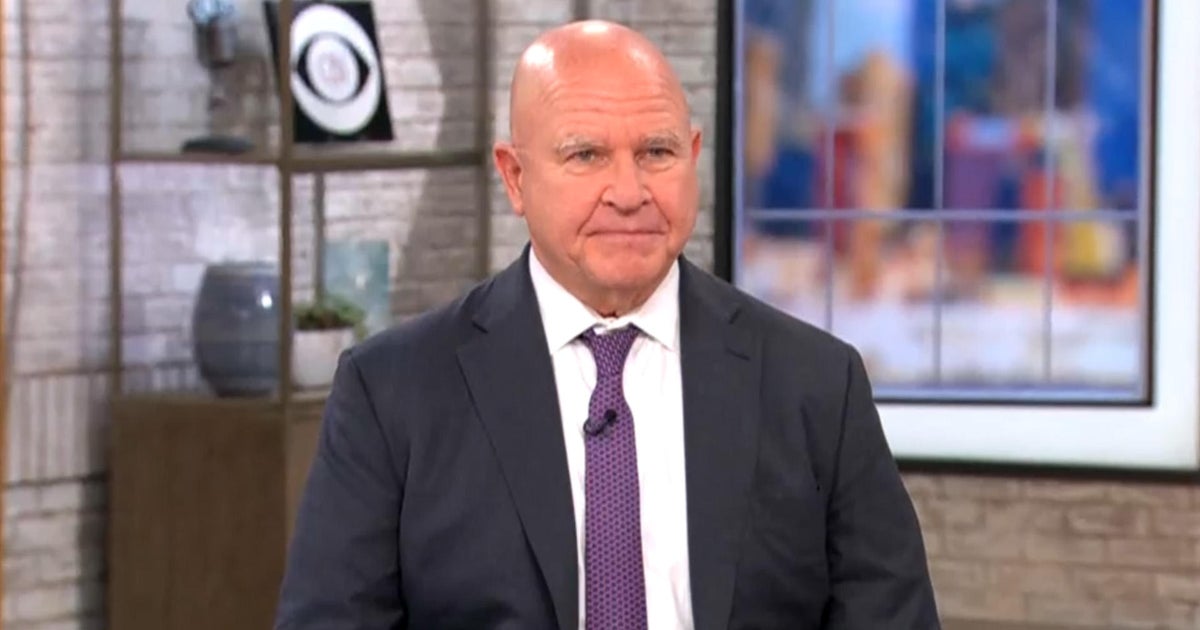
H.R. McMaster hopes to "inoculate" Trump from people who'd "push his buttons"

Schools revamp how kids are taught to read amid lagging scores

The electric-plane future is about to take off

Saving Walden Pond: How a treasured landmark is under threat
- Weird But True
- Sex & Relationships
- Viral Trends
- Human Interest
- Fashion & Beauty
- Food & Drink
trending now in Lifestyle

I'm a doctor — these are 3 daily supplements I swear by for...

Drug gang busted after smuggling cocaine worth millions in...

Horrific scan shows the disturbing effects of undercooked pork on...

NYC wine pros refuse to stock popular 'overplayed' bubbly brand

I'm a nutrition doctor — here's who should take magnesium...

Epic mongoose and cobra fight on airport tarmac delays flight

Passenger ripped for baking sourdough bread on flight: 'That’s...

Why I cut off my parents after they baby-sat my newborn: 'So...
The girl who tried to bring peace between the us and the soviet union.

Samantha Smith liked letters.
In the summer of 1977, the schoolgirl from Manchester, Maine, had written to the queen of England, congratulating her on 25 years on the throne.
She got a reply from the queen’s lady-in-waiting, thanking her for taking the trouble.
By April 1983, Samantha, now 10, was worried as Cold War tensions between the United States and the Soviet Union raised the threat of nuclear confrontation, as author Lena Nelson explains in “America’s Youngest Ambassador: The Cold War Story of Samantha Smith’s Lasting Message of Peace” (Down East Books).
On the suggestion of her mother, Jane, Smith picked up her pen again and wrote to the new leader of the Soviet Union, General Secretary Yuri Andropov.
“Congragulations (sic) on your new job,” she wrote.

“I have been worrying about Russia and the United States getting into a Nuculear (sic) war . . . Are you going to vote to have a war or not?”
Ending her letter, “PS Please write back,” Samantha headed to the post office with her father, Arthur, sending her letter to the Kremlin in Moscow, even though, as Nelson writes, she was “surprised that the stamp for a letter going to the Soviet Union cost forty cents instead of the usual twenty cents.”
From that moment, the Smiths’ life would never be the same.
When word reached the family that her letter had been published in the Russian state newspaper, Pravda, local, national and international media were suddenly on the family doorstep, demanding to know more about the girl they called “America’s Youngest Ambassador.”

“There were TV crews from England, Australia, Germany, and Bulgaria. A photographer traveled from Paris to take pictures of the family on their front porch. The Soviets sent their TV crew as well — after receiving special permission to travel to Manchester,” writes Nelson.
“When the US crews heard that the Soviets were coming to film Sam, they wanted to come film the Soviets filming.”
By April 25, a letter had arrived from Andropov himself, telling her of his desire for peace across the world and inviting her and her family over to Russia.
“Although skeptical about the Soviet leader’s true intentions, Jane and Arthur thought that the message sounded genuine,” writes Nelson.

Soon, every TV network was fighting for an interview.
She appeared on “Nightline” with Ted Koppel and flew to Los Angeles for an appearance on “The Tonight Show with Johnny Carson” (and landed a trip to Disneyland as part of the deal).
In July, the family embarked on a 2-week visit to the Soviet Union, visiting Moscow, Leningrad and the Soviet pioneer camp of Artek.
She flew to Japan to speak at the Children’s International Symposium for the 21st Century in Kobe, even learning a little Japanese for her talk, and reported from Washington, DC, for the Disney Channel, interviewing presidential candidates.

There was a cameo role in an episode of a new TV show, “Charles In Charge” with “Happy Days” actor Scott Baio — and even a part in a new ABC series, “Lime Street,” alongside “Hart to Hart” star Robert Wagner.
“Sam had no idea who Robert Wagner was,” writes Nelson.
But tragedy struck on Aug. 25, 1985.
“Samantha shone like a brilliant beam of sunshine at a time when relations between our two countries were clouded.” Soviet leader Mikhail Gorbachev
After a trip to London, England to film an episode of “Lime Street,” Samantha and her father were on the last leg of their journey home as the plane prepared to land at the small regional airport in Auburn-Lewiston, Maine.
The aircraft’s approach was too low and too fast in the fog and light rain. As it clipped some poplar trees, just under a mile short of the runway, it hit the ground, nearly upside down, and finally came to a halt in a ravine.
All eight people on board were killed, including Samantha and her father.

She was just 13.
The following day, Jane Smith read out a statement outside her house.
“Samantha couldn’t accept man’s inhumanity to man,” she said.
“She stood fast in the belief that peace can be achieved and maintained by mankind .”
On Aug. 27, meanwhile, a Western Union telegram arrived at her house, sent from Santa Barbara, Calif. “Nancy and I are profoundly saddened at the news of your great loss. A beloved husband and only daughter gone with shocking suddenness,” it read.

“Samantha – her smile, her idealism, her unaffected sweetness of spirit. Nancy joins me in sending you our deepest sympathy. May God bless and console you. Ronald Reagan.”
There was also a telegram from the new Soviet leader, Mikhail Gorbachev.
“Samantha shone like a brilliant beam of sunshine,” he wrote, ”at a time when relations between our two countries were clouded.”
Samantha’s work wasn’t in vain.

In October 1985, two months after the plane crash, Jane Smith established the Samantha Smith Foundation, an organization dedicated to promoting a greater understanding between the peoples of the United States and the Soviet Union.
The politicians upped their game as well.
A month later, and almost three years since Samantha Smith wrote to the Kremlin, President Ronald Reagan and Soviet General Secretary Mikhail Gorbachev met in Geneva, Switzerland, agreeing to intensify discussions between the superpowers.

“The Soviet and American leaders walked toward each other, their hands outstretched, and began the dialogue that would end the Cold War,” writes Nelson.
In December 1986, a full-size bronze statue of Samantha Smith was dedicated by the Maine State Library and Museum, across from the state capitol building. On a gold plaque, there is the story of her short but spectacular life.
“Samantha’s untimely death at age 13 in an airplane accident was mourned by adults and children worldwide,” it reads.
“Maine is proud of her native daughter and we remember the message she taught us: One child can play a powerful part in bringing peace to the world.”

Advertisement
- History Classics
- Your Profile
- Find History on Facebook (Opens in a new window)
- Find History on Twitter (Opens in a new window)
- Find History on YouTube (Opens in a new window)
- Find History on Instagram (Opens in a new window)
- Find History on TikTok (Opens in a new window)
- This Day In History
- History Podcasts
- History Vault
This Day In History : August 25
Changing the day will navigate the page to that given day in history. You can navigate days by using left and right arrows

Samantha Smith dies in plane crash

Samantha Smith , the 13-year-old “ambassador” to the Soviet Union , dies in a plane crash . Smith was best known for writing to Soviet leader Yuri Andropov in 1982 and visiting the Soviet Union as Andropov’s guest in 1983.
In late 1982, Smith, a fifth-grader at Manchester Elementary School in Manchester, Maine, wrote a plaintive letter to Soviet leader Andropov. She said that she was “worrying about Russia and the United States getting into a nuclear war. Are you going to have a war or not?” A few months later, Smith’s letter was reprinted in Russia and it was announced that Andropov was writing a response. Smith received his letter in April 1983. Andropov assured Smith that he did not want a nuclear war with the United States or any other country. Calling Smith a “courageous and honest” little girl, Andropov closed the letter with an invitation for her to visit the Soviet Union. In July, accompanied by her parents, Smith embarked on a two-week trip. She was a hit in the Soviet Union, and although she did not get to meet with Andropov, she traveled widely and spoke to numerous groups and people.
In the United States, some people branded her as a patsy for the communists and claimed that Soviet propagandists were merely using her for their own purposes, but Samantha’s enthusiasm and contagious optimism charmed most Americans and millions of other people around the world. During the next two years, Smith became an unofficial U.S. goodwill ambassador, speaking to groups throughout the United States and in foreign nations such as Japan. On August 25, 1985, while traveling with her father, their small plane crashed and both were killed.
Smith’s legacy lived on, however. Her mother began the Samantha Smith Foundation , which has as its goal bringing people from different nations and cultures together to share their experiences. In particular, the foundation established a student exchange program with the Soviet Union. In the Soviet Union, news of Smith’s death was met with great sadness. The Russian government responded by issuing a stamp in her honor and naming a mountain after the young girl.
Also on This Day in History August | 25

Momofuku Ando creates the first mass‑market instant ramen
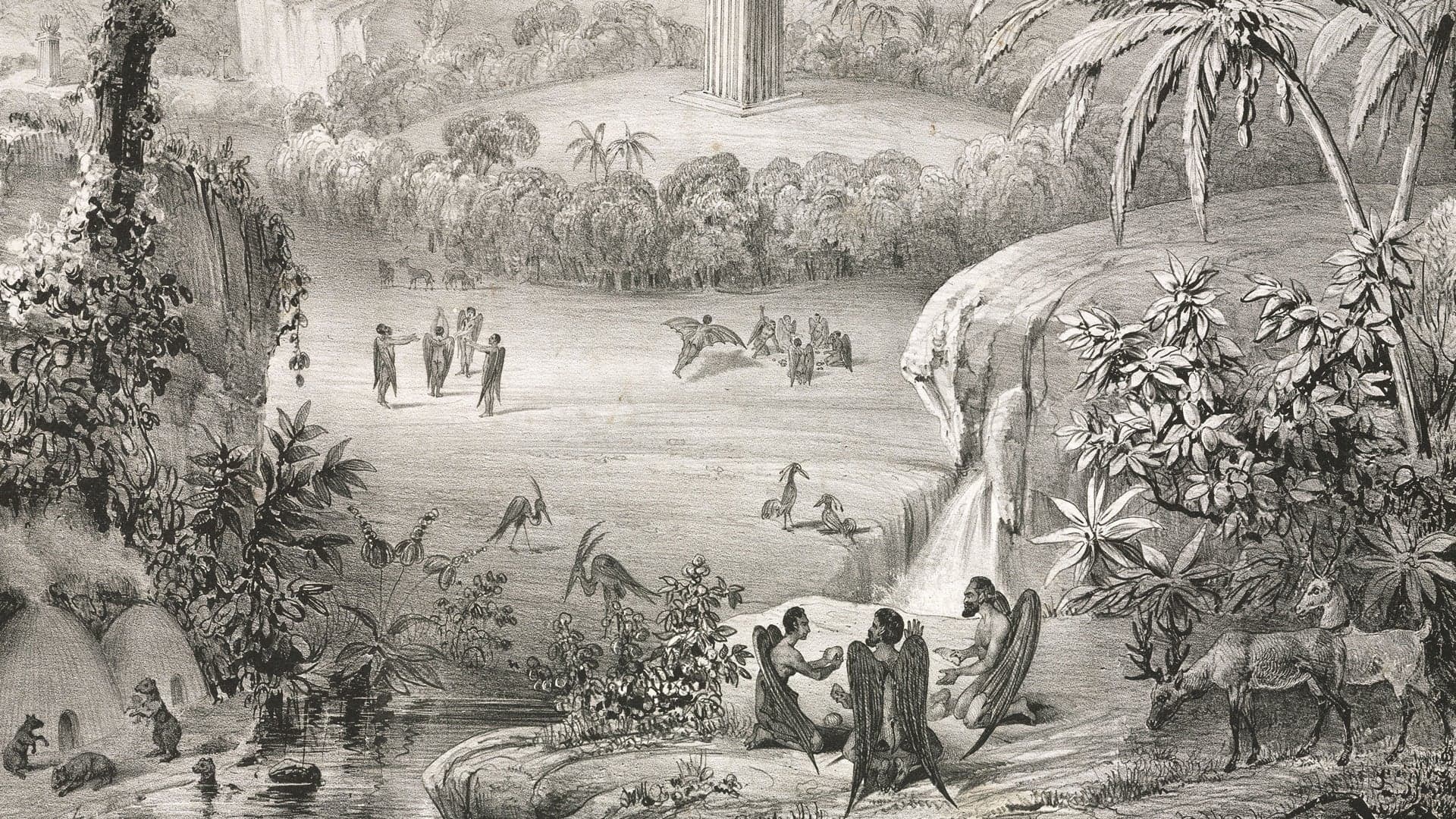
This Day in History Video: What Happened on August 25
Ted kennedy, “liberal lion of the senate,” dies at 77.
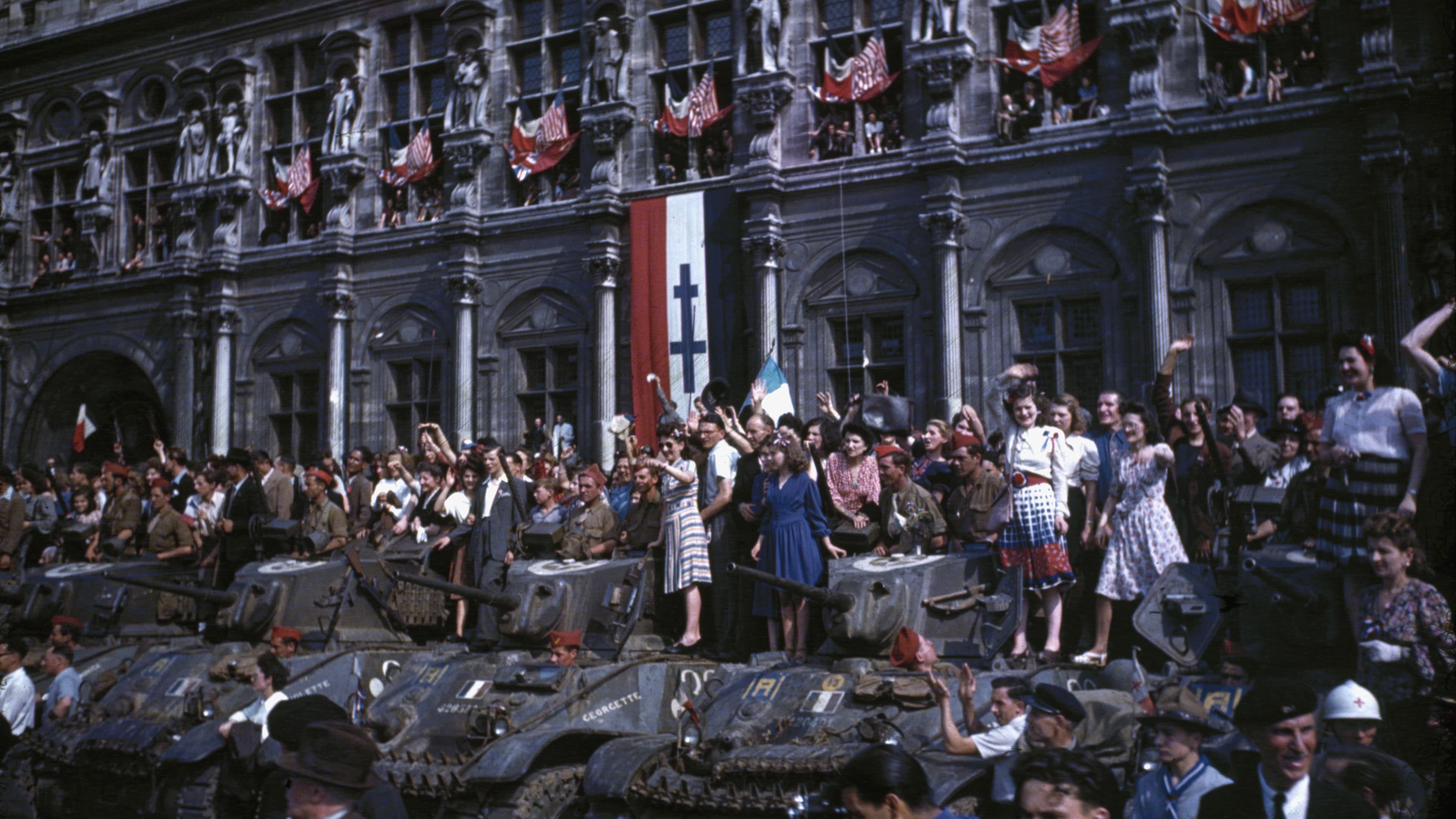
Paris is liberated after four years of Nazi occupation
Little eva earns a #1 hit with “loco‑motion”, u.s. marines deployed to lebanon.

Wake Up to This Day in History
Sign up now to learn about This Day in History straight from your inbox. Get all of today's events in just one email featuring a range of topics.
By submitting your information, you agree to receive emails from HISTORY and A+E Networks. You can opt out at any time. You must be 16 years or older and a resident of the United States.
More details : Privacy Notice | Terms of Use | Contact Us
Englishman swims the Channel
"the great moon hoax" is published in the "new york sun", germans burn belgian town of louvain, truman orders army to seize control of railroads, outlaw bill doolin is killed, "the wizard of oz" opens in u.s. theaters, yangtze river peaks in gaoyou, china, killing more than 10,000, hurricane david is born, truman capote, author of “in cold blood,” dies.

Samantha Smith
Sep 5, 2021
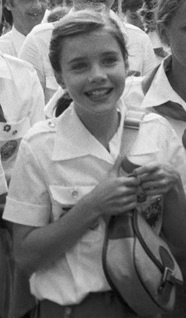
Yuryi Abramochkin / Юрий Абрамочкин
Samantha was born in Maine, United States and lived during the Cold War between the United States and the Soviet Union. In November 1982, Yuri Andropov became leader of the Soviet Union. It was during this time that Samantha, aged ten in December 1982, decided to write to Yuri Andropov and ask how to improve the tense relations between her country and the Soviet Union after seeing on T.V. the impact a nuclear was would have on the world. You can read Samantha’s letter and Yuri Andropov’s reply here .
Samantha did not receive a reply for a long time. Instead she found out her letter had been published in a Soviet newspaper in April 1983. So she wrote to the Soviet Ambassador to the United States asking if she would get a reply. In response she got a letter back from Yuri Andropov. He stated he did not want war with the US and asked Samantha and her parents to come visit the Soviet Union in the summer. What a response! The US media publicized her story and as a result, Samantha became a young American ambassador for peace.
`In July 1983, Samantha and her parents went to the Soviet Union as guests of Yuri Andropov. She visited Moscow, Leningrad (now St. Petersburg), and Artek, a Soviet pioneer camp on the Crimean Peninsula. The Soviet media followed her trip closely and she declared the Russian people to be “just like us.” The trip was such a success that later in the year she was also invited to Japan to attend a Children’s International Symposium. She gave a speech at the symposium and suggested that the American and Soviet leaders should exchange granddaughters for two weeks every year because a president “wouldn’t want to send a bomb to a country his granddaughter would be visiting.”
Samantha continued her activism with a T.V. special, Samantha Smith Goes to Washington: Campaign ’84 . She interviewed political leaders across all parties about the main issues of the campaign. She continued to travel the United States speaking to groups as a goodwill ambassador. She also started to guest star in other T.V. shows. One of these took her to London in August 1985. On the way back with her father, both were killed when the small airplane they were travelling in crashed on August 25th, 1985.
In both the U.S. and the Soviet Union, Samantha’s death was met with sadness. Her mother began the Samantha Smith Foundation to continue her work fostering peace through international friendships of children. The state of Maine marked the first Monday in June as Samantha Smith Day and in the Soviet Union she had her likeness on a stamp and an asteroid named in her honour.
Related Entries
- Josephine Baker
Pin It on Pinterest
- Bahasa Indonesia
- Slovenščina
- Science & Tech
- Russian Kitchen
This American girl was a celebrity in the USSR
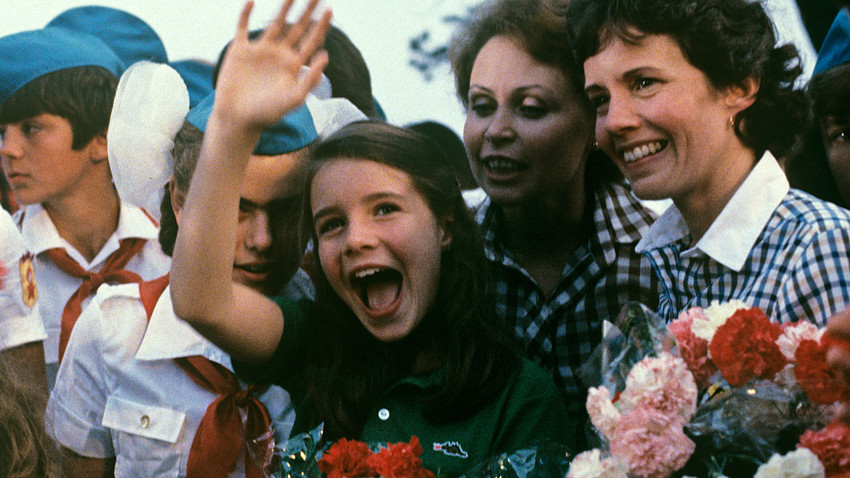
In July 1983, the whole world witnessed an amazing event: an ordinary 11 year-old American girl wrote a letter to the Kremlin and was invited to visit the Soviet Union. Her name was Samantha Smith, and she became America’s youngest-ever Goodwill Ambassador.
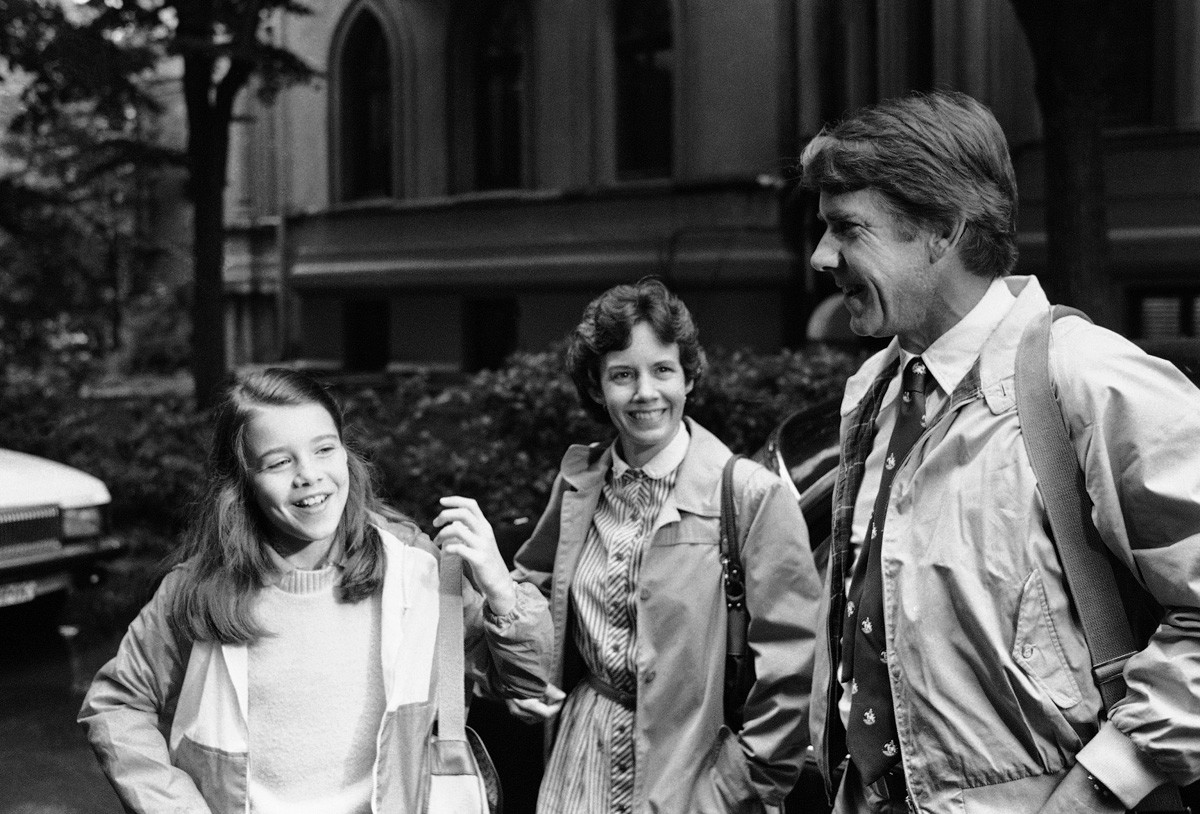
In the early 1980s, Samantha was living with her parents in the small New England town of Manchester, Maine. As so often happened during the Cold War, the world at that time was again on the precipice of a global nuclear conflict between the U.S. and the Soviet Union. And while politicians played their games, common people lived under a permanent cloud of fear and anxiety.
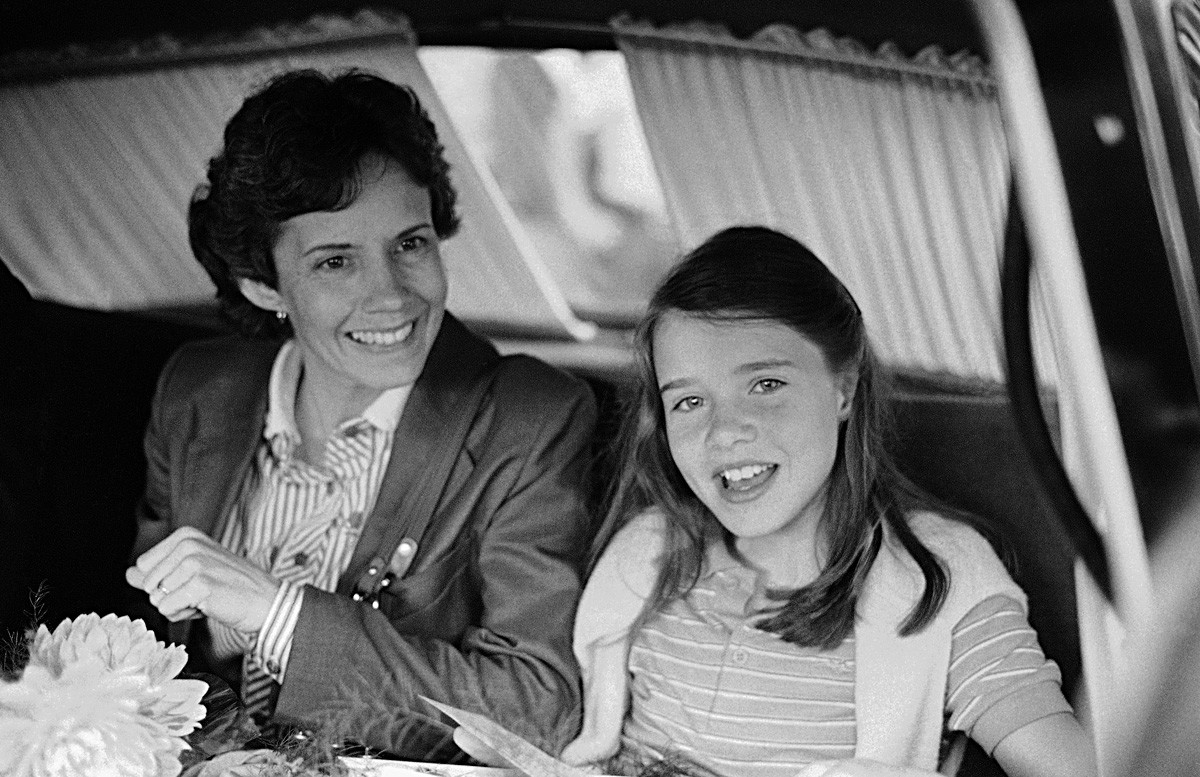
Once, on a magazine cover Samantha saw a photo of the Soviet leader Yuri Andropov, who the U.S. media labelled the bad guy in this tense geopolitical situation. Samantha asked her mother: “If people are so afraid of him, why doesn't someone write a letter asking whether he wants to have a war or not?" “Why don’t you?” her mother replied.
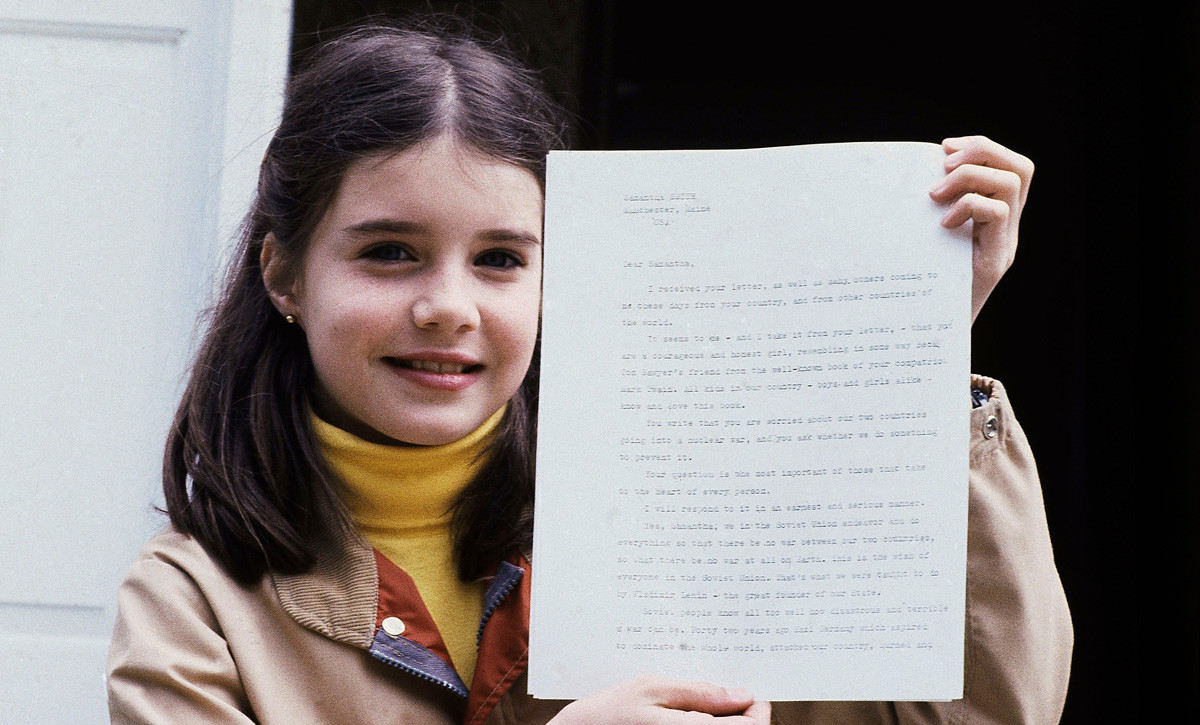
Her mom soon forgot the conversation, but not Samantha. She took the advice seriously and in several days sent a letter to Andropov, where she asked whether he really wanted to start a war and conquer the whole world or at least the U.S. The letter ended with the line: “God made the world for us to live together in peace and not to fight.”
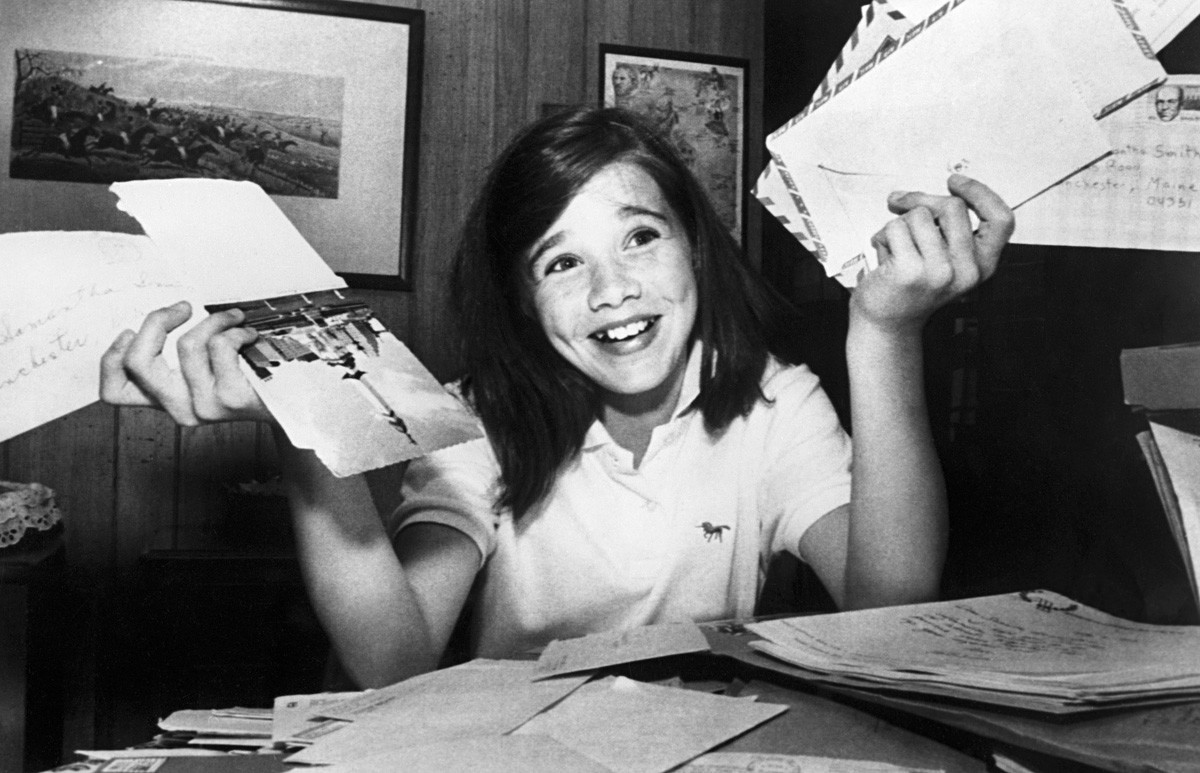
Surprisingly, leading Soviet newspaper Pravda published an extract from her letter. Any other girl may have been happy with that, but not Samantha. She didn’t understand why nobody had answered her questions, and wrote another letter.
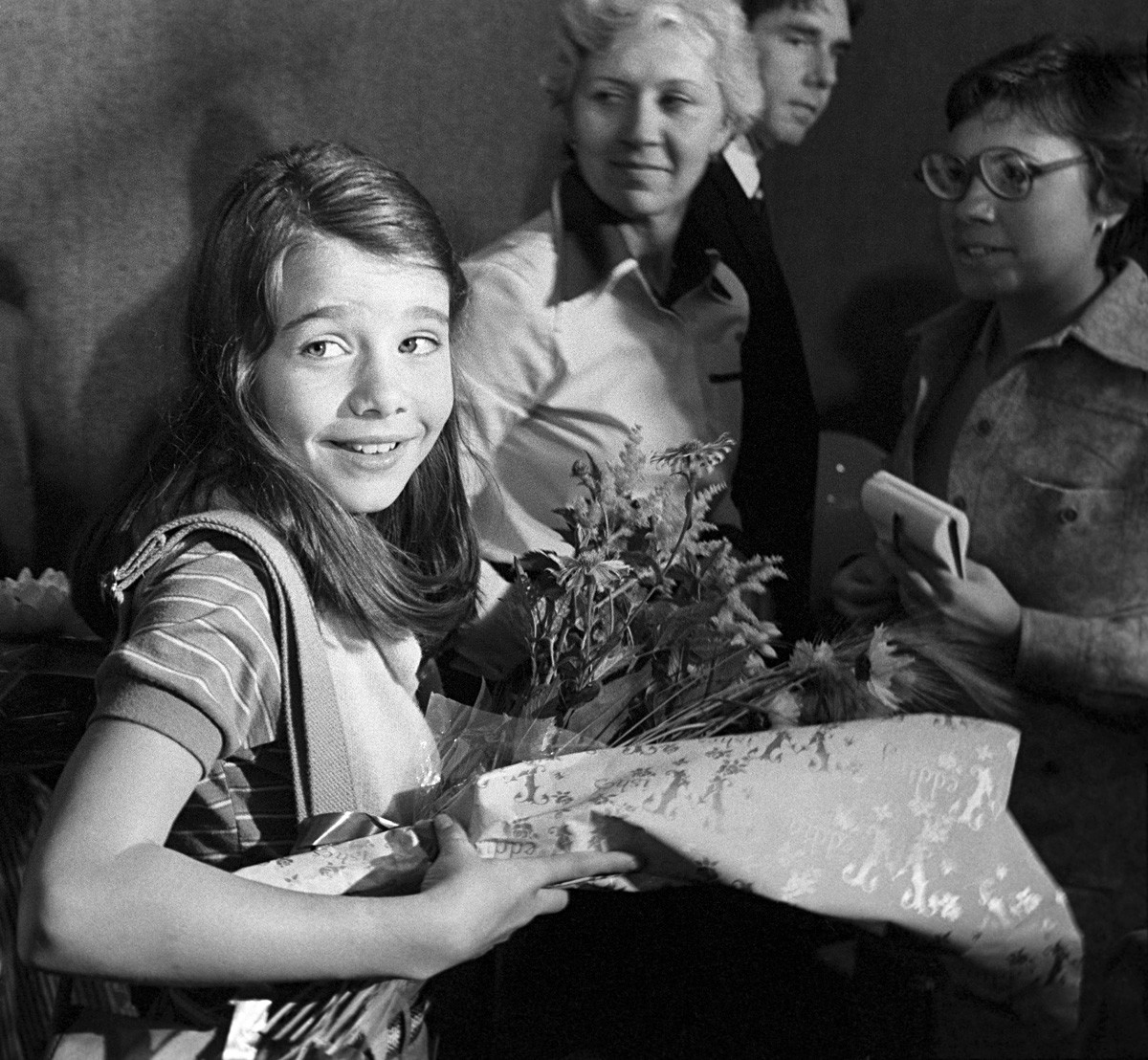
This time Yuri Andropov himself sent a response, laying out the Soviet position: “We want peace for ourselves and for all the peoples of the planet. For our children and for you, Samantha,” he wrote, inviting her to visit the USSR and to see for herself that “in the Soviet Union, everyone is for peace and friendship among peoples.”
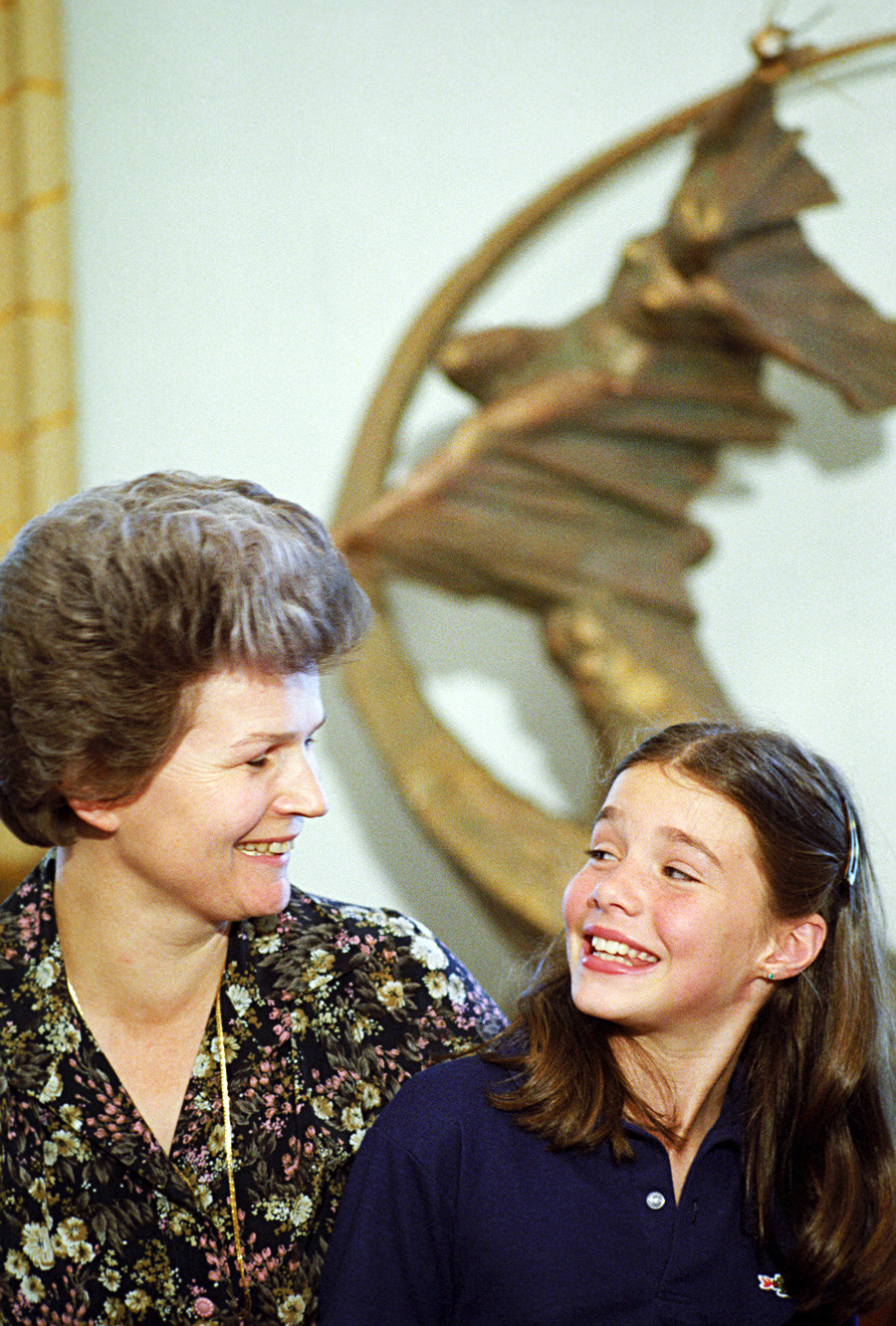
On 7 July, Samantha arrived in the Soviet Union with her parents for a two-week visit. Treated like visiting royalty, she visited all the main sights in Moscow and Leningrad (St. Petersburg).
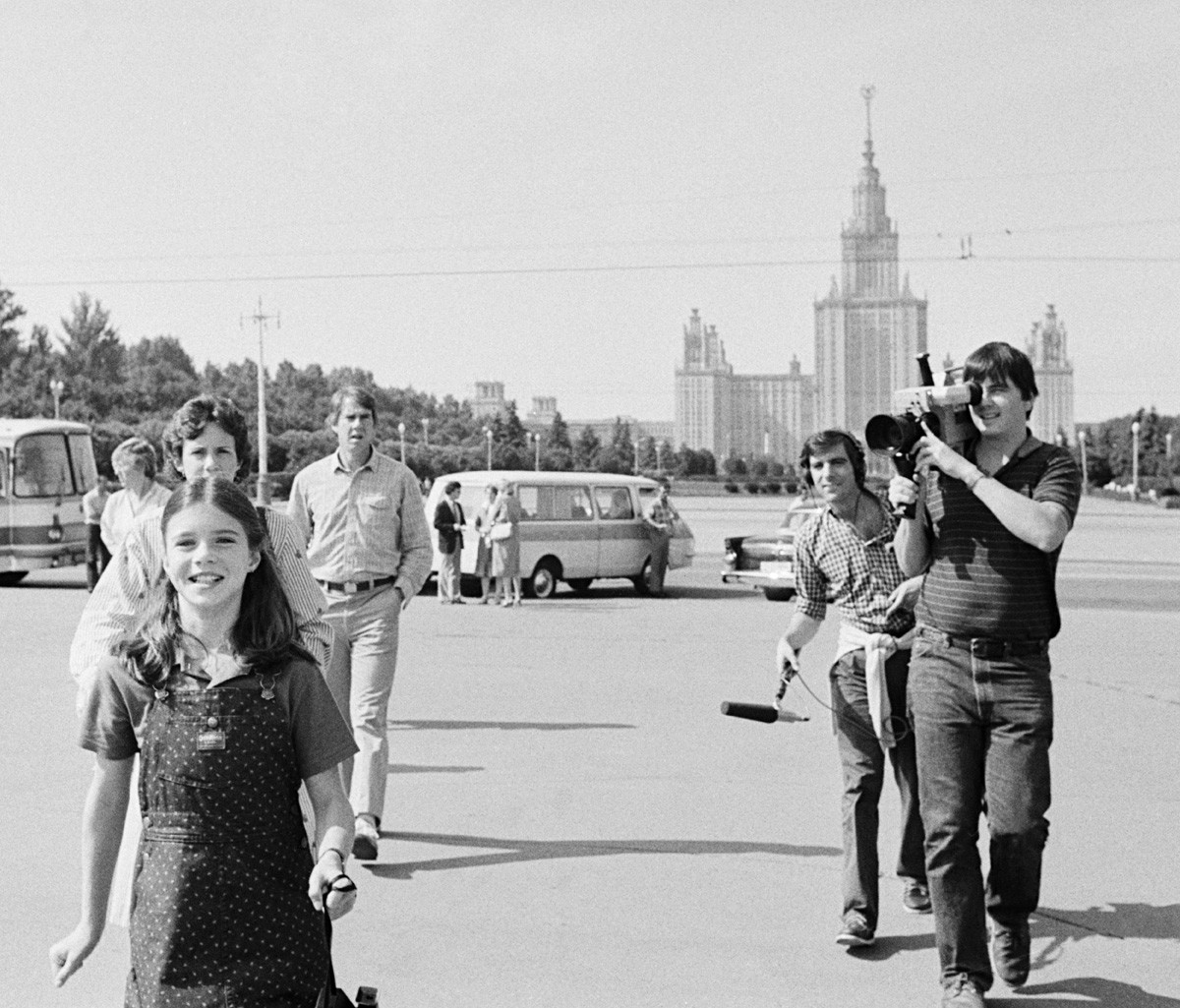
Samantha also spent several days at a top Soviet Young Pioneer youth organisation camp at Artek in Crimea, where she met youngsters from all over the Soviet Union, took part in festivities, stage shows and various activities. She was presented with a Young Pioneer uniform - though without the habitual red tie to avoid any political connotations.
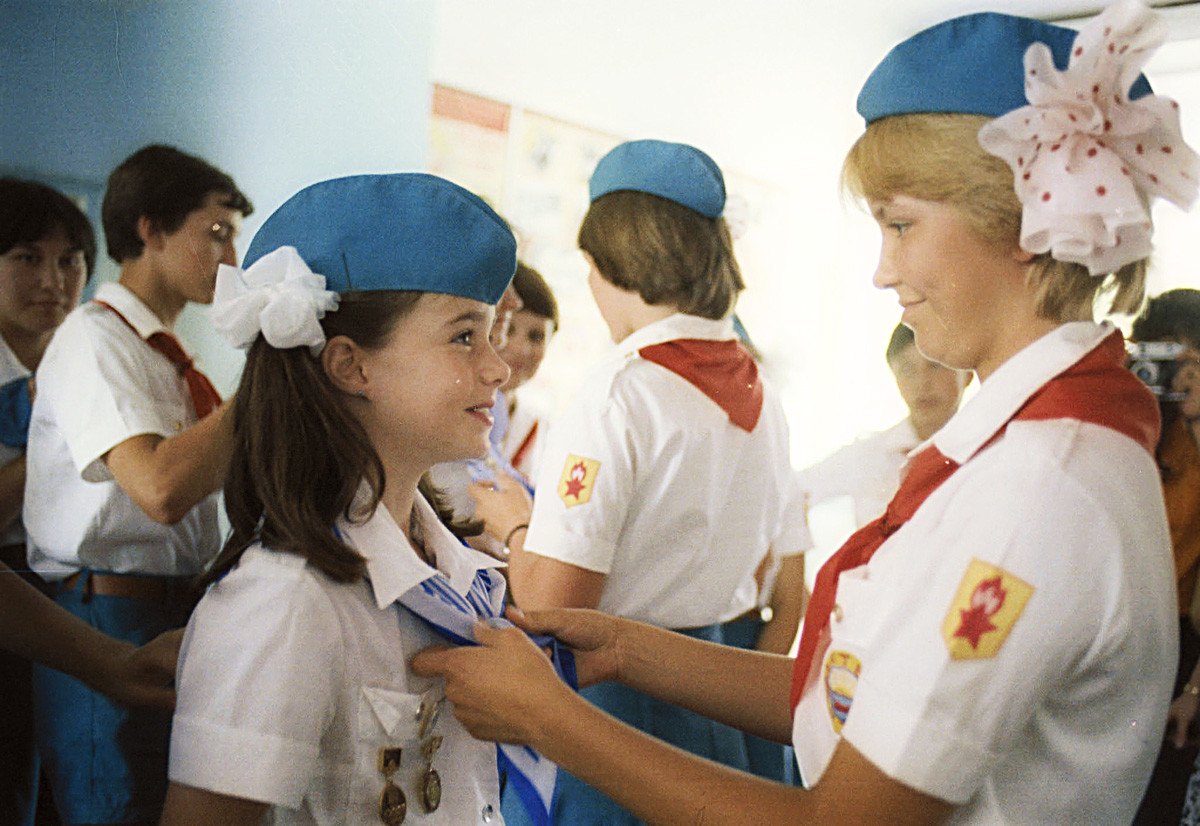
Samantha’s every step was covered by American and Soviet journalists. Brainwashed by propaganda, people in both countries could finally see that people on opposite sides of the Iron Curtain didn’t differ much from each other.
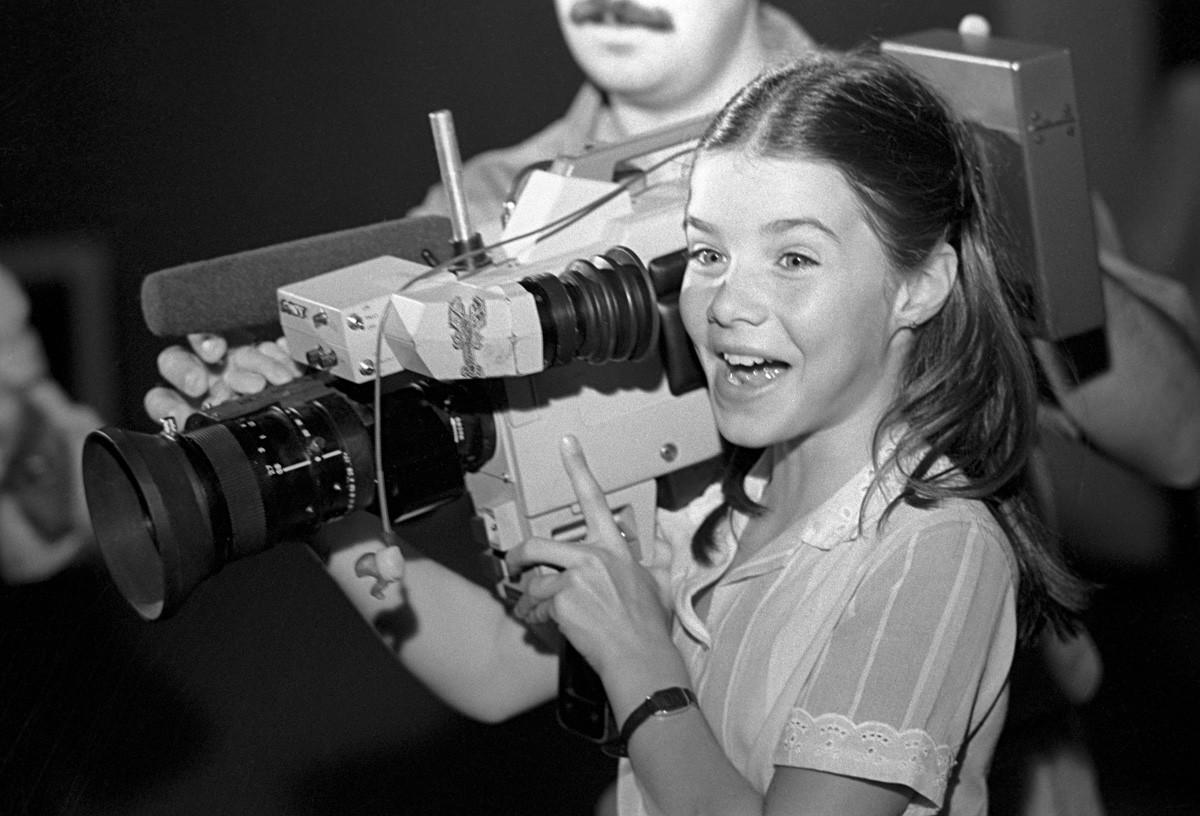
Sadly Samantha was unable to meet Andropov himself - he was already a very sick man at the time. He died less than a year after her visit.

Returning to the U.S., Samantha Smith declared: ’’Now I am certain the Russians, like the Americans, do not want war.” Russians are ‘’just like us,’’ she added.
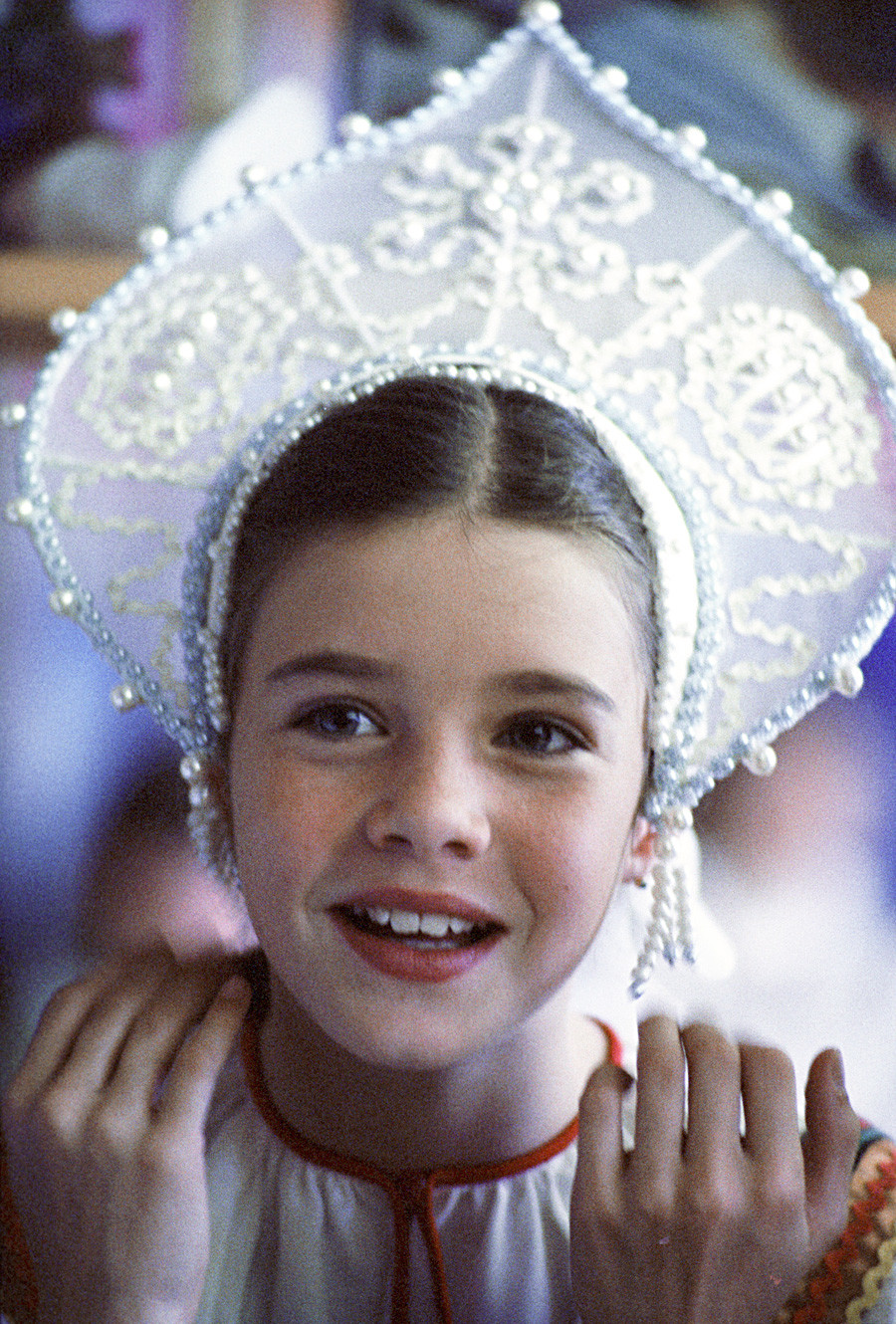
Samantha’s Soviet trip made her a true celebrity. As the youngest Goodwill Ambassador she visited Japan, was a guest on talk shows at home, and appeared in the cast of popular TV shows. Unfortunately, her promising life came to an abrupt and premature end on 25 august 1985 when she died in an air accident. Her death shocked the world and was mourned in the U.S. and the USSR alike.
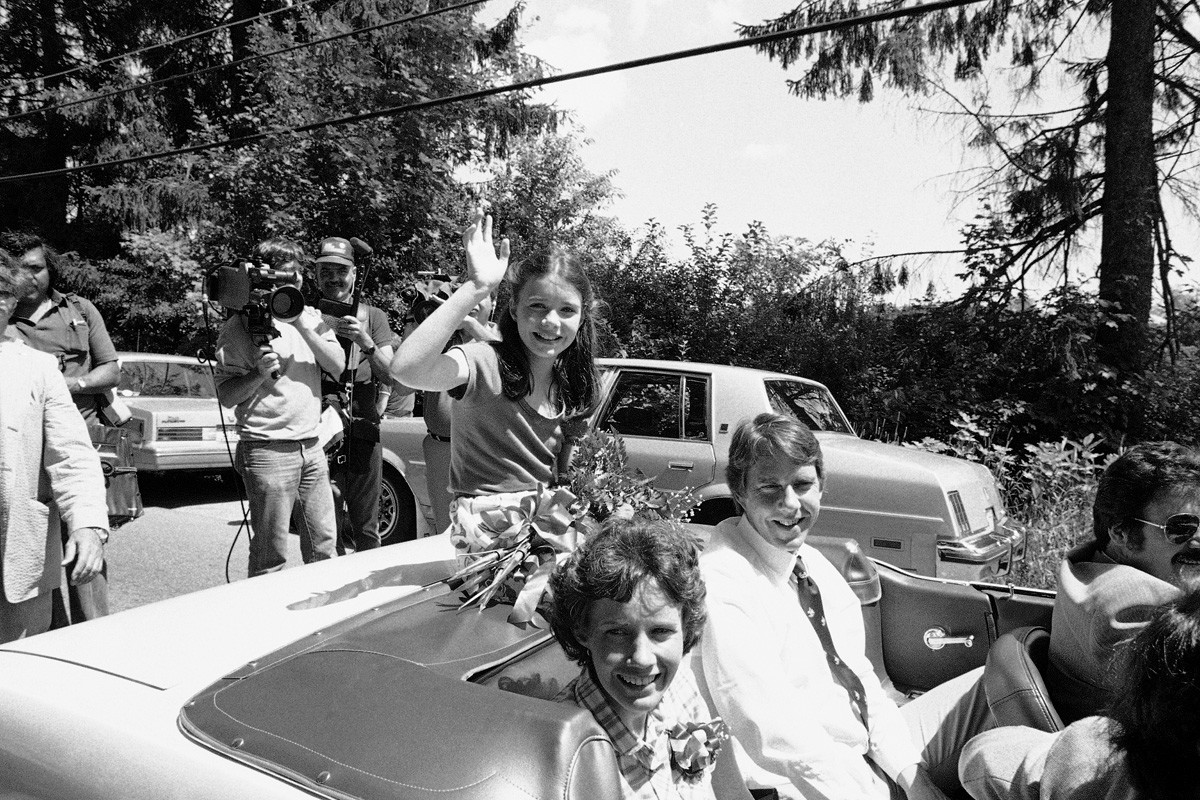
In 1986, the Soviet Union decided to organize a return visit to the U.S. However, although 12 year-old Katya Lycheva’s visit was widely covered by the American media - and she even met President Ronald Reagan - she lacked Samantha’s charisma and charm and never became as popular as the little American peace activist.
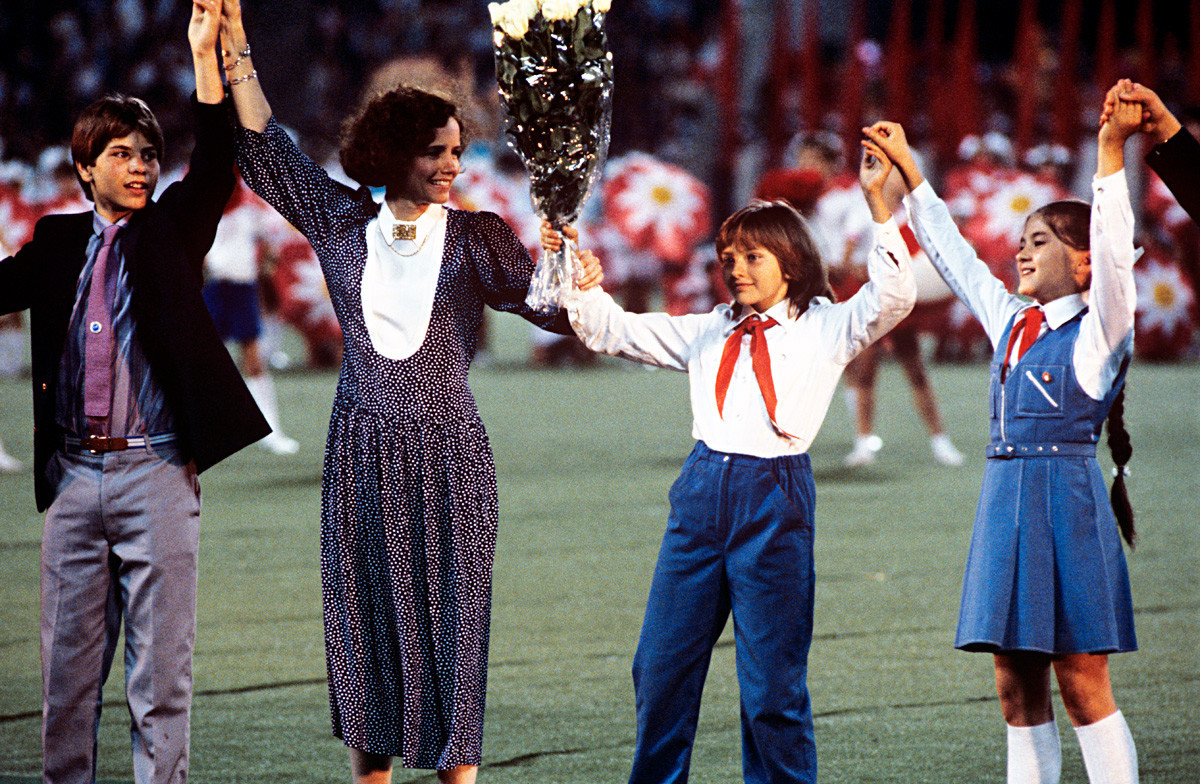
If using any of Russia Beyond's content, partly or in full, always provide an active hyperlink to the original material.
to our newsletter!
Get the week's best stories straight to your inbox
- Russians and Americans: Why we don't understand each other
- 4 best-loved Americans in the USSR
- How Soviet girl Katya Lycheva met Reagan and helped end the Cold War
This website uses cookies. Click here to find out more.

www.SamanthaSmith.info

On July 7, 1983, Samantha and her family departed for Moscow. Cheerful, blue-eyed Samantha seemed so unlike the “armed to the teeth Americans” that often appeared in Soviet political cartoons. Media crews from all over the world filmed her swimming with the Soviet kids at camp Artek and being a perfect diplomat as she visited the Red Square.
Smith family’s tour was broadcast on the two available Soviet channels, and we were glued to the TV screens following the girl’s every move. For many of us in the Soviet Union Samantha and her family put a human face on the U.S. On the other side of the ocean, Americans got a rare glimpse of the Soviet Union.
When two years later Samantha and her father were tragically killed in a commercial plane crash, I stood in front of my black and white TV stunned by fragility of life. Gorbachev, who by then was the new Soviet leader, sent a telegram to Jane Smith: “Everyone in the Soviet Union who has known Samantha Smith will forever remember the image of the American girl who, like millions of Soviet young men and women, dreamt about peace, and about friendship between the peoples of the United States and the Soviet Union.”
President Ronald Reagan in his letter of condolences wrote, “Perhaps you can take some measure of comfort in the knowledge that millions of Americans, indeed millions of people, share the burdens of your grief. They also will cherish and remember Samantha, her smile, her idealism and unaffected sweetness of spirit.”
“I was very concerned at the time with what was happening,” says Gorbachev on the 30th anniversary of Samantha’s trip, “and once I assumed the post of the General Secretary I immediately set out to renew contacts at the highest level. During his second presidential term, Ronald Reagan too understood that it was best to go down in history as someone who stood for peace, rather than for war.”
Once, during one of the summits, Gorbachev recalls telling Reagan: “Mr. President, I have a feeling that our people have a better grasp of the situation and are able to come to an understanding sooner than you and I can. If this continues, they will fire us.”
In October 1985, Jane Smith founded the Samantha Smith Foundation, which sponsored Soviet-American exchanges for the next decade. A statue of Samantha letting out a peace dove, with a bear sitting at her feet, now stands at the entrance of the Maine State Museum in Augusta. The Soviet government issued a commemorative stamp; a diamond, a mountain, a cultivar of tulips, and even an asteroid were given Samantha’s name.
Following her trip Samantha wrote: “I mean, if we could be friends by just getting to know each other better, then what are our countries really arguing about? Nothing could be more important than not having a war if a war would kill everything.”
“I feel,” says Gorbachev, “that was it not for Samantha’s tragic death she could have been an active participant in social change and do a lot of good.”
Thirty years ago, in the summer of 1983, 11-year-old Samantha Smith from Manchester, Maine, was the most famous little girl in the world. Images of a freckle-faced smiling Samantha holding a letter from the Soviet Premier Yuri Andropov and later touring the Soviet Union went out on all news wires.
“Actually, the whole thing started when I asked my mother if there is going to be a war,” Samantha wrote in her book, “Journey to the Soviet Union.”
“There was always something on television about missiles and nuclear bombs. … I remembered that I woke up one morning and wondered if this was going to be the last day of the Earth,” she wrote.
In 1983 when I went to school on the other side of the Iron Curtain — in Arkhangelsk — my teacher used to describe what would happen when the nuclear blast hits, “We all will be like grains of sand, aimlessly strewn about.”
When I set out to write a tribute to my childhood hero on the 30th anniversary of her trip to the Soviet Union, which is July 7-21, I contacted former President Mikhail Gorbachev — to find out whether he shared the sentiment of my generation about the effect Samantha’s short letter had on U.S.-Soviet relations. He poignantly described the timeliness of Samantha’s message:
“Samantha Smith wrote her letter to Yuri Andropov at the moment when the Cold War has reached its peak. The Soviet and American leaders hadn’t had a meeting in years. Missiles that could reach their targets in five minutes of flight time were being deployed in Europe.”
In response to her daughter’s question about war, Jane Smith showed Samantha a November 1982 Time magazine, with stern bi-spectacled Andropov gracing its cover. In it some U.S. experts were concerned about escalating U.S.-Soviet conflict; others saw “the transfer of power in the Kremlin [as] an opportunity to relieve tensions.”
Samantha’s reaction: “If everyone is so afraid of him, why don’t they ask him if he is going to start a war?”
“Why don’t you write to him?” suggested Jane.
Samantha did just that. She penned a question that was on the minds of many adults, “Are you going to vote to have a war or not?” She addressed the envelope, “Mr. Yuri Andropov, the Kremlin, Moscow, USSR,” mailed it and soon forgot about it.
When called to the phone in Secretary Peabody’s office at her Manchester Elementary School several months later, Samantha learned from an United Press International reporter that her letter was published in Pravda. Baffled as to why she didn’t receive a response, Samantha wrote another letter — to the Soviet Embassy in Washington, D.C. Andropov’s response arrived a little more than a week later.
“It was the sincerity of Samantha’s letter that garnered attention,” continued Gorbachev. “We understood at the time that people on both sides of the ocean were very worried, and they wanted to make sure that their concern was felt by the leaders of USSR and USA. An American girl was able to express that in her letter.”
By the time Samantha got home from school that day, her lawn was covered with reporters. By evening she and her mother were bound for New York for interviews on NBC and CBS. In his letter Andropov wrote that Soviets didn’t want to start a war. They were busy “growing wheat, building and inventing, writing books and flying into space.” And he invited Samantha’s family to visit USSR in the summer.
by Lena Nelson
This story has originally appeared in the Bangor Daily News on July 10, 2013 as President Gorbachev Reflects on America's Youngest Ambassador, Samantha Smith by Lena Nelson
Samantha Smith's Story
Soviet Girl, 11, Flies to U.S. on Tour Saluting Samantha Smith
- Copy Link URL Copied!
Soviet schoolgirl Katerina Lycheva, saying she wants an “Earth without weapons,” flew to the United States today on a peace tour in memory of Samantha Smith, the American youngster who visited the Soviet Union in 1983.
The 11-year-old fifth-grader won the two-week trip to the United States for suggesting that her school establish a memorial “museum” to Samantha, who died in a plane crash in Maine last year.
Katya, as she is known to her friends, was to begin the tour in Chicago. She was also to visit New York, Washington, Houston and Los Angeles.
Tass said Katya “was childishly excited before her long voyage and did not conceal that she was proud of having been awarded the special Samantha Smith prize of the American Children as Peacemakers organization.”
Katya will carry letters to Samantha’s mother, gifts for American schoolchildren and a special present for President Reagan, although no meeting at the White House is planned. Samantha made her visit as a guest of the late Soviet leader Yuri V. Andropov but she did not see the Kremlin leader.
At a news conference on the eve of her departure, Katya said she wants to tell American children “that all Soviet people, big and small, are against war.”
“I would like to see the Earth without weapons, with only kitchen knives left to peel potatoes and cut meat,” the blue-eyed blonde told reporters.
She will be accompanied on the trip by her mother, Marina, and a delegation of the Soviet peace committee.
More to Read
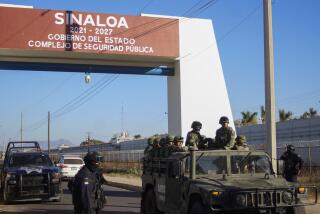
Are Mexican drug cartels as powerful as people think?
Aug. 28, 2024
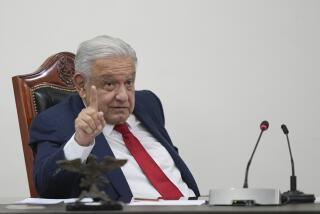
Mexico’s president announces ‘pause’ in relationship with U.S. Embassy after criticism from ambassador
Aug. 27, 2024

Telegram messaging app CEO freed from police custody, will appear in court
Sign up for Essential California
The most important California stories and recommendations in your inbox every morning.
You may occasionally receive promotional content from the Los Angeles Times.
More From the Los Angeles Times
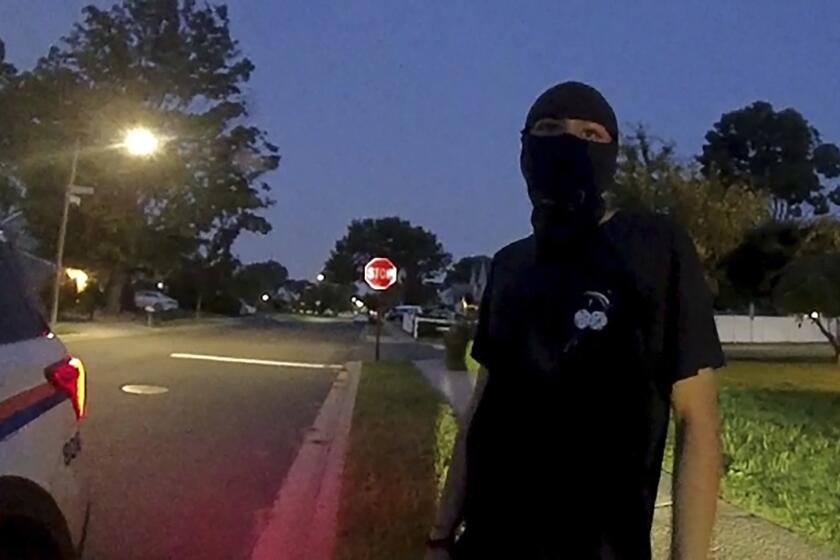
World & Nation
Police in suburban New York county make first arrest under law banning face masks
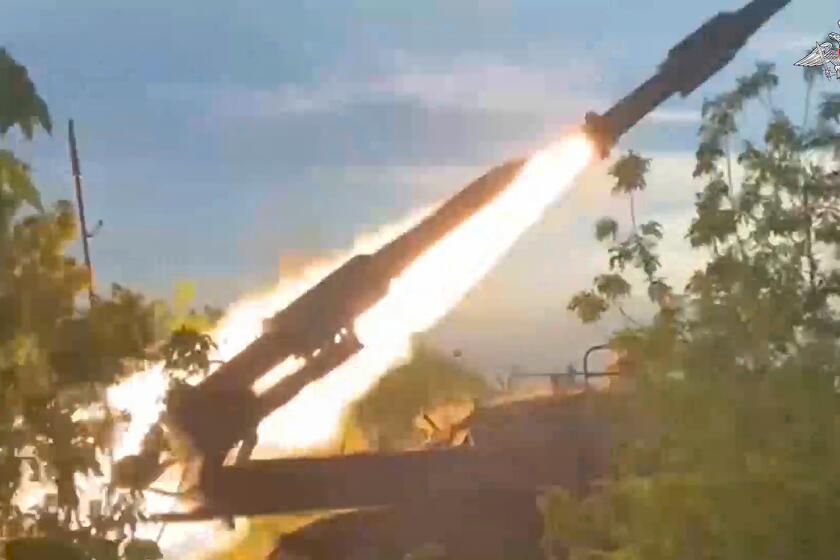
Russian missile hits Ukrainian president’s home city as it mourns deaths in an earlier attack

Israeli forces launch major operation in West Bank, kill at least 10 Hamas militants
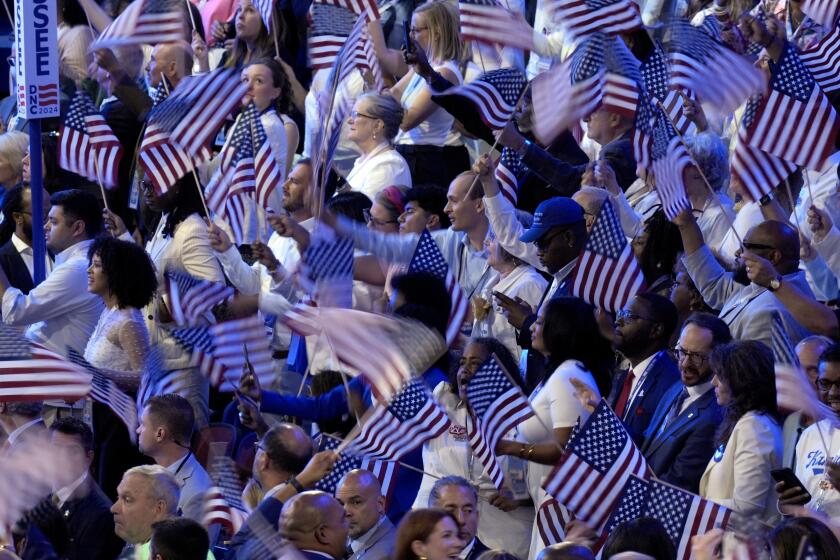
Abcarian: Are Kamala Harris’ Democrats taking back the flag-waving patriotism claimed by Republicans?

American Women Visit the Soviet Union
U.S. members of the Women’s International League for Peace and Freedom visit with Soviet women in Moscow and several other cities to promote… read more
U.S. members of the Women’s International League for Peace and Freedom visit with Soviet women in Moscow and several other cities to promote peace and understanding in the midst of the Cold War. One of the delegates is former Representative Helen Gahagan Douglas (D-CA). This Soviet film with English narration is part of the Swarthmore College Peace Collection. close
Javascript must be enabled in order to access C-SPAN videos.
- Text type Text Graphical Timeline
- Search this text
*This text was compiled from uncorrected Closed Captioning.
Hosting Organization
- Central Documentary Film Studio, Moscow (USSR) Central Documentary Film Studio, Moscow (USSR)
- Reel America
Airing Details
- Mar 20, 2021 | 10:34pm EDT | C-SPAN 3
- Mar 21, 2021 | 4:34pm EDT | C-SPAN 3
- Mar 22, 2021 | 2:36am EDT | C-SPAN 3
- Mar 26, 2021 | 8:38pm EDT | C-SPAN 3
- Mar 27, 2021 | 12:38am EDT | C-SPAN 3
- Mar 27, 2021 | 4:37am EDT | C-SPAN 3
- Mar 27, 2021 | 8:35am EDT | C-SPAN 3
- Mar 29, 2021 | 8:35am EDT | C-SPAN 3
- Mar 29, 2021 | 12:27pm EDT | C-SPAN 3
- Mar 29, 2021 | 4:21pm EDT | C-SPAN 3
- Mar 29, 2021 | 7:42pm EDT | C-SPAN 3
Related Video
NBC Report on the Women's Movement
This series that aired on NBC beginning in September 1969 looks at the women’s movement. Hosted by several female corres…
Paul Simon on Women's Issues
Senator Paul Simon addressed the Women’s Agenda Conference in Des Moines, Iowa on the issues facing American women. Sena…
U.S.-Soviet Moscow Summit Compilation
President Ronald Reagan met with General Secretary Mikhail Gorbachev in Moscow May 29-June 2, 1988. This compilation inc…
Presidential Speech
President Ronald Reagan spoke at the World Affairs Council in Los Angeles, California.
Advertisement
Where Kamala Harris Stands on the Issues: Abortion, Immigration and More
She wants to protect the right to abortion nationally. Here’s what else to know about her positions.
- Share full article

By Maggie Astor
- Published July 21, 2024 Updated Aug. 24, 2024
With Vice President Kamala Harris having replaced President Biden on the Democratic ticket, her stances on key issues will be scrutinized by both parties and the nation’s voters.
She has a long record in politics: as district attorney of San Francisco, as attorney general of California, as a senator, as a presidential candidate and as vice president.
Here is an overview of where she stands.
Ms. Harris supports legislation that would protect the right to abortion nationally, as Roe v. Wade did before it was overturned in 2022, in Dobbs v. Jackson Women’s Health Organization.
After the Dobbs ruling, she became central to the Biden campaign’s efforts to keep the spotlight on abortion, given that Mr. Biden — with his personal discomfort with abortion and his support for restrictions earlier in his career — was a flawed messenger. In March, she made what was believed to be the first official visit to an abortion clinic by a president or vice president.
She consistently supported abortion rights during her time in the Senate, including cosponsoring legislation that would have banned common state-level restrictions, like requiring doctors to perform specific tests or have hospital admitting privileges in order to provide abortions.
As a presidential candidate in 2019, she argued that states with a history of restricting abortion rights in violation of Roe should be subject to what is known as pre-clearance for new abortion laws — those laws would have to be federally approved before they could take effect. That proposal is not viable now that the Supreme Court has overturned Roe.
Climate change
Ms. Harris has supported the Biden administration’s climate efforts , including legislation that provided hundreds of billions of dollars in tax credits and rebates for renewable energy and electric vehicles.
“It is clear the clock is not just ticking, it is banging,” she said in a speech last year , referring to increasingly severe and frequent disasters spurred by climate change. “And that is why, one year ago, President Biden and I made the largest climate investment in America’s history.”
During her 2020 presidential campaign, she emphasized the need for environmental justice , a framework that calls for policies to address the adverse effects that climate change has on poor communities and people of color. She has emphasized that as vice president as well.
In 2019, Ms. Harris, then a senator, and Representative Alexandria Ocasio-Cortez, Democrat of New York, introduced legislation that would have evaluated environmental rules and laws by how they affected low-income communities. It would have also established an independent Office of Climate and Environmental Justice Accountability and created a “senior adviser on climate justice” within several federal agencies. In 2020, Ms. Harris introduced a more sweeping version of the bill. None of the legislation was passed.
Ms. Harris was tasked with leading the Biden administration’s efforts to secure voting rights legislation, a job she asked for . The legislation — which went through several iterations but was ultimately blocked in the Senate — would have countered voting restrictions in Republican-led states, limited gerrymandering and regulated campaign finance more strictly.
This year, she met with voting rights advocates and described a strategy that included creating a task force on threats to election workers and challenging state voting restrictions in court.
She has condemned former President Donald J. Trump’s efforts to overturn the 2020 election results. In a speech in 2022 marking the anniversary of the Jan. 6, 2021, attack on the Capitol, she said that day had showed “what our nation would look like if the forces who seek to dismantle our democracy are successful.” She added, “What was at stake then, and now, is the right to have our future decided the way the Constitution prescribes it: by we the people, all the people.”
Economic policy
In campaign events this year, Ms. Harris has promoted the Biden administration’s economic policies, including the infrastructure bill that Mr. Biden signed, funding for small businesses, a provision in the Inflation Reduction Act that capped the cost of insulin for people on Medicare and student debt forgiveness.
She indicated at an event in May that the administration’s policies to combat climate change would also bring economic benefits by creating jobs in the renewable energy industry. At another event , she promoted more than $100 million in Energy Department grants for auto parts manufacturers to pivot to electric vehicles, which she said would “help to keep our auto supply chains here in America.”
As a senator, she introduced legislation that would have provided a tax credit of up to $6,000 for middle- and low-income families, a proposal she emphasized during her presidential campaign as a way to address income inequality.
Immigration
One of Ms. Harris’s mandates as vice president has been to address the root causes of migration from Latin America, like poverty and violence in migrants’ home countries. Last year, she announced $950 million in pledges from private companies to support Central American communities. Similar commitments made previously totaled about $3 billion.
In 2021, she visited the U.S.-Mexico border and said : “This issue cannot be reduced to a political issue. We’re talking about children, we’re talking about families, we are talking about suffering.”
More recently, she backed a bipartisan border security deal that Mr. Biden endorsed but Mr. Trump, by urging Republican lawmakers to kill it , effectively torpedoed. The legislation would have closed the border if crossings reached a set threshold, and it would have funded thousands of new border security agents and asylum officers. “We are very clear, and I think most Americans are clear, that we have a broken immigration system and we need to fix it,” Ms. Harris said in March .
Israel and Gaza
Ms. Harris called in March for an “immediate cease-fire” in Gaza and described the situation there as a “humanitarian catastrophe.” She said that “the threat Hamas poses to the people of Israel must be eliminated” but also that “too many innocent Palestinians have been killed.”
In an interview later that month , she emphasized her opposition to an Israeli invasion of Rafah, the city in southern Gaza to which more than a million people had fled. “I have studied the maps,” she said. “There’s nowhere for those folks to go, and we’re looking at about 1.5 million people in Rafah who are there because they were told to go there, most of them.”
She has said on multiple occasions that she supports a two-state solution.
Racial justice
Racial justice was a theme of Ms. Harris’s presidential campaign. In a memorable debate exchange in 2019 , she denounced Mr. Biden’s past work with segregationist senators and opposition to school busing mandates.
She has called for ending mandatory minimum sentences, cash bail and the death penalty, which disproportionately affect people of color.
Amid the protests that followed the police killing of George Floyd in 2020, she was one of the senators who introduced the Justice in Policing Act, which would have made it easier to prosecute police officers, created a national registry of police misconduct and required officers to complete training on racial profiling. It was not passed.
Her record as a prosecutor also came into play during her presidential campaign. Critics noted that as attorney general of California, she had generally avoided stepping in to investigate police killings.
Maggie Astor covers politics for The New York Times, focusing on breaking news, policies, campaigns and how underrepresented or marginalized groups are affected by political systems. More about Maggie Astor

IMAGES
COMMENTS
Samantha Reed Smith (June 29, 1972 - August 25, 1985) was an American peace activist and child actress from Manchester, Maine, who became famous for her anti-war outreaches during the Cold War between the United States and the Soviet Union.In 1982, Smith wrote a letter to the newly appointed General Secretary of the Communist Party of the Soviet Union, Yuri Andropov, and received a personal ...
American girl Samantha Smith (center) visited the U.S.S.R. on the invitation of General Secretary Yuri Andropov in July 1983. Here, she's visiting the Artek pioneer camp. Wikimedia Commons. Even ...
At 10 years old, American school girl Samantha Smith became a peace activist between the United States and the Soviet Union during the Cold War. Her letter to the Soviet Union's General Secretary, Yuri Andropov, and subsequent visit to the USSR, altered the tense relationship between the two opposing countries.
January 29, 2023 / 9:43 AM EST / CBS News. In 1982, at one of the frostiest moments in the Cold War, a fifth-grade girl from Manchester, Maine named Samantha Smith wrote a letter to Soviet Union ...
Samantha Smith, an 11-year-old American girl, begins a two-week visit to the Soviet Union at the invitation of Soviet leader Yuri Andropov. Some American observers believed that Smith was merely ...
In his letter, he invited Samantha and her parents to visit the Soviet Union and witness the country's dedication to peace and friendship among peoples. The exchange between Samantha and Andropov garnered significant media attention. She appeared on the Johnny Carson show, and major American networks reported the news. The trip
In July, the family embarked on a 2-week visit to the Soviet Union, visiting Moscow, Leningrad and the Soviet pioneer camp of Artek. ASSOCIATED PRESS Smith takes a tour of the Novodevichy Convent ...
Samantha Smith, the 13‑year‑old "ambassador" to the Soviet Union, dies in a plane crash. Smith was best known for writing to Soviet leader Yuri Andropov in 1982 and visiting the Soviet ...
A year later, after Samantha's letter was published in the Soviet newspaper Pravda, she received a personal reply with an invitation to visit Russia, which she accepted. On July 7, 1983 she flew ...
Samantha Smith (1972-1985) was an American schoolgirl and peace campaigner, famously invited to the Soviet Union during the early 1980s. Smith was born, raised and educated in Maine in the north-eastern United States. In November 1982 Smith, then aged 10, wrote a brief letter to newly elected Soviet leader Yuri Andropov.Smith's letter congratulated Andropov on his appointment, then expressed ...
Katya Lycheva (L) and her new American friend Star Rowe during Katya's visit. TASS The Soviet Union agreed, and promptly held "auditions" - attended by around 6,000 hopefuls.
Samantha Smith. Sep 5, 2021. Yuryi Abramochkin / Юрий Абрамочкин. Samantha was born in Maine, United States and lived during the Cold War between the United States and the Soviet Union. In November 1982, Yuri Andropov became leader of the Soviet Union. It was during this time that Samantha, aged ten in December 1982, decided to ...
Samantha Reed Smith (June 29, 1972 - August 25, 1985) was an American schoolgirl from Manchester, Maine, who became known as "America's Youngest Ambassador" in the United States and the "Goodwill Ambassador" in the Soviet Union during her short lifetime.. She became famous in these two nations and well-known around the world through the simple act of writing a letter to the leader of the ...
In July 1983, the whole world witnessed an amazing event: an ordinary 11 year-old American girl wrote a letter to the Kremlin and was invited to visit the Soviet Union.
Samantha Smith was a 10 year old girl from Maine. In November 1982 Smith, at the suggestion of her mother, wrote to Soviet leader Yuri Andropov, asking if he intended to start a war.The friendly exchange between Smith and Andropov occurred at a time of considerable tension and acrimony between the US and Soviet Russia, so received media coverage around the world:
Thirty years ago, in the summer of 1983, 11-year-old Samantha Smith from Manchester, Maine, was the most famous little girl in the world. Images of a freckle-faced smiling Samantha holding a letter from the Soviet Premier Yuri Andropov and later touring the Soviet Union went out on all news wires. "Actually, the whole thing started when I ...
Yet, in the Soviet Union the images of the giggly, smiling American girl (Figure 1) having lots of fun with her Soviet peers at Artek provided the press with visual evidence to produce a coherent narrative of a young American girl who enthusiastically embraced her host country and became convinced that 'Russians, like Americans, do not want ...
Soviet schoolgirl Katerina Lycheva, saying she wants an "Earth without weapons," flew to the United States today on a peace tour in memory of Samantha Smith, the American youngster who visited the ...
U.S. members of the Women's International League for Peace and Freedom visit with Soviet women in Moscow and several other cities to promote peace and understanding in the midst of the Cold War ...
The state visit of Nikita Khrushchev to the United States was a 13-day visit from 15-27 September 1959. It marked the first state visit of a Soviet or Russian leader to the US. Nikita Khrushchev, then First Secretary of the Communist Party of the Soviet Union and Chairman of the Council of Ministers, was also the first leader of the Soviet ...
Second Soviet Union-issued postage stamp dedicated to Pavlichenko. The American folk singer Woody Guthrie composed a song ("Miss Pavlichenko") as a tribute to her war record and to memorialize her visits to the United States and Canada. [21] [non-primary source needed] It was released as part of The Asch Recordings. [22] [23] [non-primary ...
1:00 p.m. - Soviet Premier Nikita Khrushchev, his wife Nina, son Sergei, daughters Julia and Rada, and son-in-law Alexei Adzhubei landed at Andrews Air Force Base in Maryland, just outside of ...
Fact-Checking Biden's Speech and More: Day 1 of the Democratic National Convention. We followed the developments and fact-checked the speakers, providing context and explanation.
With Vice President Kamala Harris having replaced President Biden on the Democratic ticket, her stances on key issues will be scrutinized by both parties and the nation's voters.. She has a long ...